Baby Care & Parenting Blogs

How to Perform an Abhyanga Massage for Babies
Massaging your baby is not just a way to relax and bond; it’s a time-honored tradition that has been passed down through generations in India. Known as Abhyanga, this Ayurvedic practice involves the gentle application of warm oil all over the body. Abhyanga massages offer several benefits, including promoting healthy skin, improving circulation, and helping babies sleep better.
For new parents, performing an Abhyanga massage might feel intimidating at first, but with a little practice and patience, it can become a calming routine that both you and your baby look forward to. In this blog, we’ll walk through how to perform an Abhyanga massage for your baby step by step while also explaining the numerous benefits this practice provides.
What is Abhyanga Massage?
Abhyanga is a form of Ayurvedic massage that involves applying warm oil to the skin in long, gentle strokes. Traditionally, oils like sesame oil, coconut oil, or almond oil are used, each offering its own unique benefits. In babies, Abhyanga helps improve skin texture, promotes better blood flow, and can even soothe a fussy child, helping them to relax and sleep more soundly.
In Ayurveda, it is believed that regular oil massages help in balancing the doshas (Vata, Pitta, and Kapha) in the body, which is important for overall well-being. For babies, it also strengthens the immune system and supports their physical development.
Benefits of Abhyanga Massage for Babies
Before we explain how to give an Abhyanga massage, let’s look at why it’s so beneficial for your baby:
-
Improves Circulation:
The gentle strokes during the massage help boost blood flow, which is essential for healthy growth and development.
-
Promotes Relaxation:
A good massage helps soothe your baby’s nervous system, calming them down and making them feel secure.
-
Aids Digestion:
Massaging the stomach area can help with gas, colic, and constipation.
-
Boosts Immune System:
Regular massages help stimulate the lymphatic system, which in turn strengthens the immune system.
-
Encourages Better Sleep:
The warmth of the oil and the rhythmic movements promote relaxation, which helps babies sleep more soundly.

Choosing the Right Oil for Abhyanga Massage
Selecting the right oil for your baby’s massage is an important step. Some of the most commonly used oils include:
-
Sesame Oil:
This is a classic Ayurvedic oil known for its warming properties. It’s especially good for babies born in colder months as it helps retain body heat.
-
Coconut Oil:
Known for its cooling and moisturizing properties, coconut oil is great for babies born during the summer or those with sensitive skin.
-
Almond Oil:
Almond oil is rich in vitamin E, which nourishes the skin and is suitable for all skin types.
-
Olive Oil:
Often used in many homes, olive oil is light and easily absorbed, making it ideal for regular use.
How to Perform an Abhyanga Massage for Your Baby
Now that you know why Abhyanga is so beneficial, let’s break down the steps of giving your baby a soothing and effective massage.
Step 1: Set Up a Comfortable Space
Find a quiet, warm place in your home where you and your baby can relax. Lay down a soft towel or blanket on a firm surface. Make sure the room is at a comfortable temperature, so your baby doesn’t get too cold.
Step 2: Warm the Oil
Pour a small amount of your abyanga oil into a bowl and gently warm it. You can do this by placing the bowl in hot water for a few minutes. Make sure the oil is comfortably warm, but not too hot, by testing it on the inside of your wrist.
Step 3: Start with the Legs
Begin the massage with your baby’s legs. Using your hands, apply the warm oil and gently stroke downwards from the thigh to the ankle. Use firm but gentle pressure and remember to massage both the front and back of the legs. This helps stimulate circulation and muscle development.
Step 4: Move to the Arms
Next, apply oil to your baby’s arms, starting from the shoulders and working your way down to the wrists. You can also massage their tiny hands by gently opening their palms and pressing lightly on each finger. This not only improves circulation but also enhances sensory development.
Step 5: Massage the Chest and Tummy
With gentle strokes, massage your baby’s chest. You can make small circular motions around the chest area, which can help open up the lungs and improve breathing. When massaging the tummy, use circular motions in a clockwise direction to aid digestion and reduce gas or colic.
Step 6: Back and Spine
Gently turn your baby over onto their tummy and apply oil to the back. Using your hands, move in long strokes from the neck down to the bottom of the spine. This is especially relaxing for your baby and helps with the development of their spinal muscles.
Step 7: Massage the Head and Face
Lastly, apply a small amount of oil to your baby’s scalp and massage gently with your fingertips. This promotes hair growth and calms your baby. For the face, use your fingers to gently stroke from the centre of the forehead outward, down the nose, and across the cheeks.
Step 8: Finish with the Feet
Babies love having their feet massaged! Use your thumbs to press lightly on the soles of your feet in circular motions. This helps improve circulation and stimulates the nerve endings in the feet, promoting overall well-being.
Baby Forest’s Shishu Abhyanga Oils
For parents seeking a natural, safe, and effective oil for their baby’s Abhyanga massage, Baby Forest’s Shishu Abhyanga Oils is a fantastic option. This all-in-one oil combo set is designed to provide the perfect oils for your baby’s body and hair massage needs. The combo includes:
-
Maasoom Malish Baby Body Massage Oil:
A gentle body massage oil that nourishes and hydrates your baby’s skin, perfect for daily use.
-
Nanhi Champi Baby Hair Massage Oil:
This oil promotes healthy hair growth and strengthens the scalp, making it ideal for regular head massages.
-
Badami Sneh Organic Almond Cold Pressed Oil:
Rich in vitamin E, this oil deeply nourishes your baby’s skin, leaving it soft and smooth.
-
Narial Tailam Organic Cold Pressed Coconut Oil:
Known for its cooling and moisturizing properties, this coconut oil is perfect for keeping your baby’s skin hydrated, especially during warmer months.
What makes the Shishu Abhyanga Oils even more special is the addition of a complimentary surprise gift—a delightful toy or a handy travel kit, making the set a complete package for your baby’s care routine.
To use these oils, simply warm a small amount in your hands and apply it gently to your baby’s body or hair, following the steps outlined for an Abhyanga massage. The nourishing blend of natural oils will help relax your baby, improve their skin and hair health, and promote restful sleep, making it an essential part of your baby’s daily care routine.
When Should You Do Abhyanga?
Abhyanga can be done daily, preferably before bath time. Some parents like to do it in the morning, while others prefer a gentle massage before bedtime to help their baby sleep. Whatever time you choose, try to be consistent so your baby begins to recognize the routine and feel secure.
Conclusion
As you incorporate Abhyanga into your baby’s daily routine, you’re not only helping their body grow and develop but also nurturing their sense of security and love. So, take your time, enjoy the process, and know that with each gentle stroke, you’re supporting your baby’s health and happiness.
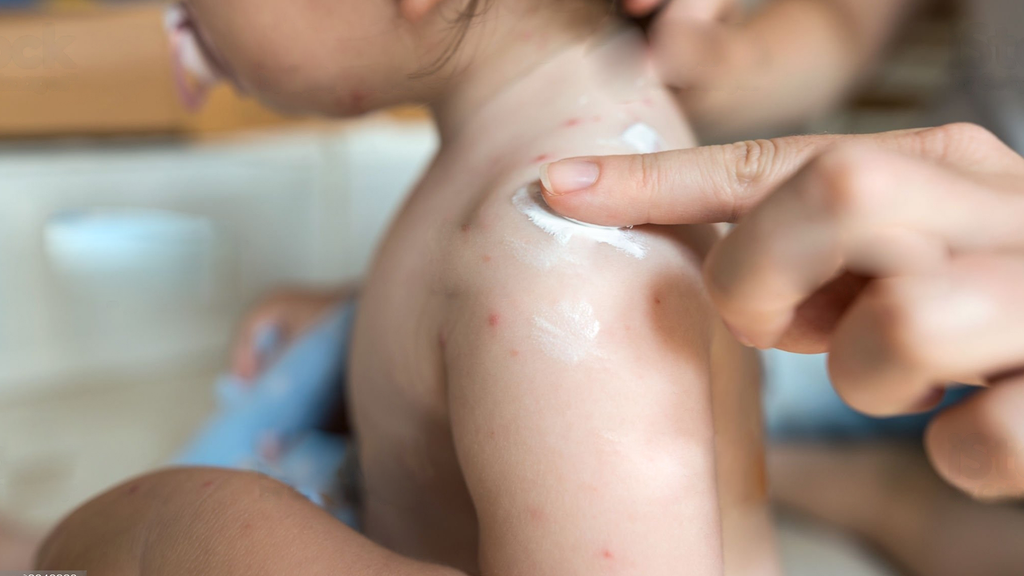
Common Skin Conditions in Babies: An Expert Guide for Par...
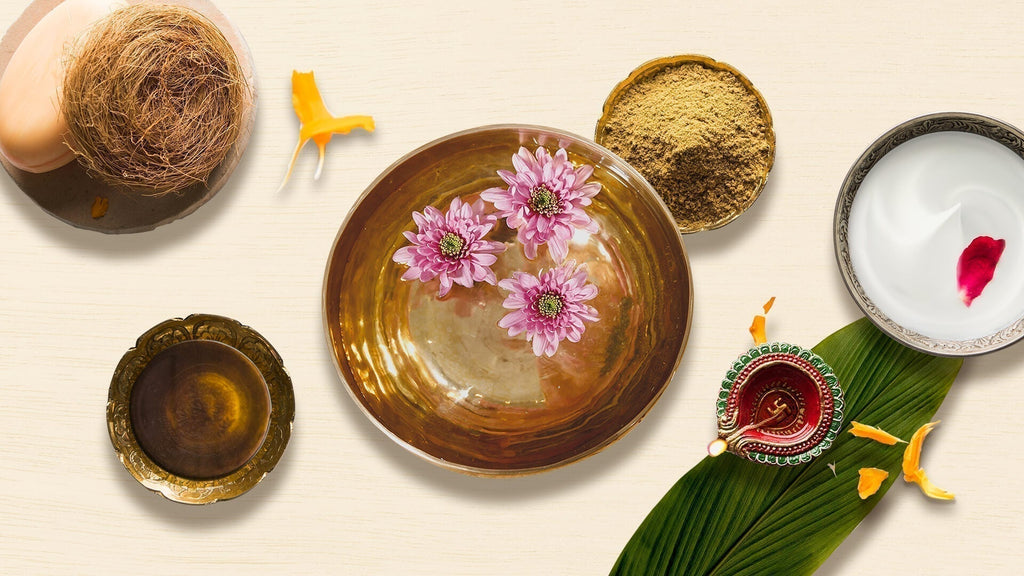
Baby Bath Ritual: An Essential Ritual for Baby’s Growth &...
Baby bath rituals in India are deeply rooted in the ancient holistic wellness concepts of Ayurveda and are intrinsic to mother and childcare. According to Ayurveda, bathing is a therapeutic, healing experience that restores physical energy, removes accumulated toxins, sweat, and dirt from the baby’s skin, and relaxes the mind by balancing emotions. While it may seem like a simple task, a baby bath ritual is packed with benefits that go beyond just cleanliness.
A baby’s first bath is considered one of the most nourishing, cleansing, and comforting experiences in their early life.
Benefits of Bathing a Baby Daily
Many parents wonder whether they should bathe their baby every day. The benefits of bathing a baby daily is numerous and go far beyond maintaining hygiene. Daily baths, especially at a fixed time, help relax the baby, restore their balance, and promote natural growth. Establishing this routine can make the baby feel more secure and comfortable.
-
Calms and Relaxes
Bathing has a calming effect on babies, which can help them sleep better, particularly if included as part of their bedtime routine.
-
Cleanses Skin Gently:
Daily bathing helps remove dirt, sweat, and accumulated oils, ensuring your baby’s skin stays fresh and healthy.
-
Promotes Circulation:
Bathing improves blood circulation, which helps the baby's muscles relax, fostering overall physical development.
How to Bathe a Newborn: A Step-by-Step Guide
Understanding the proper baby bath procedure is essential for new parents. Bathing a newborn may seem overwhelming, but following these steps can make the experience smooth and enjoyable.

Step 1: Warm Oil Massage Before Bath Time
According to Ayurveda, a warm oil body massage is essential for the baby as it controls aggravated Vata Dosha, emphasizing the belief that touch therapy creates a beautiful, deep bond between the mother and child. Before the bath, use gentle oils to massage the baby’s body, helping soothe their muscles and prepare them for the bath.
Baby Forest has formulated the Maasoom Maalish baby body massage oil with a blend of 10 Ayurvedic essential oils. These oils, derived from herbs, flowers, and medicinal plants, strengthen the baby’s blood vessels, improve blood circulation, and help in bone development.
Step 2: Gentle Cleanse During the Bath
According to Ayurvedic philosophy, a bath helps in eliminating stress, cleansing the skin, and soothing the nerves.
To ensure a gentle cleanse, use Baby Forest’s luxurious Sampoorna Snan Baby Body Wash. This product, enriched with Ayurvedic herbs and oils, keeps your baby’s delicate skin hydrated, maintains its natural moisture, and leaves it soft and supple.
Step 3: Deep Moisturizing After Bath
After a refreshing bath, it’s crucial to lock in moisture to prevent your baby’s skin from drying out. Apply the Moh Malai Baby body lotion, a lightweight, deeply hydrating cream enriched with Shea butter, Rose Petals, and Mulethi. It penetrates deeply into the skin, ensuring intense moisturization and nourishment.
Must Have Baby Hair Care Products
Many parents overlook the importance of caring for their baby’s hair. Just like skin, a baby’s hair requires gentle care and attention. Baby hair products that are mild and formulated for sensitive skin are crucial to ensure that the baby’s scalp stays clean and healthy.
-
Shampooing:
Use a mild baby shampoo that’s free from harsh chemicals. A gentle formula cleanses without stripping away the natural oils, keeping the scalp healthy.
-
Hair Oil:
For babies with a dry scalp, applying a small amount of baby hair oil can help keep their hair soft and manageable.
Baby Forest offers specially formulated baby hair care products that are gentle on the baby’s scalp and keep their hair healthy and shiny.

Creating a Soothing Bath Time Routine
The key to a successful baby bath procedure is making sure the environment is calm, and the baby feels secure. Here’s how to make the process even more soothing for your baby:
-
Use Soothing Music or Lullabies:
Playing soft music or singing to your baby during bath time can create a comforting atmosphere.
-
Introduce Bath Toys:
For older babies, adding toys to bath time can make the experience more engaging and fun.
-
Maintain Eye Contact and Smile:
A reassuring smile and gentle eye contact help your baby feel safe and loved during the bath.
Baby Bath Essentials: What You Need
Having the right products makes all the difference in ensuring a smooth, safe, and enjoyable bath time. Here’s a quick look at the must-have baby bath essentials:
|
Bath Essential |
Why You Need It |
|
Mild Baby Soap |
Gentle on your baby’s sensitive skin, cleanses without irritation. |
|
Soft Washcloth |
Perfect for cleaning those tiny folds and creases. |
|
Baby Bathtub |
Provides a safe, secure space for the baby to bathe. |
|
Hooded Baby Towel |
Keeps your baby cozy and warm right after the bath. |
|
Moisturizing Lotion |
Helps lock in moisture, protecting delicate skin from dryness. |
|
Water Thermometer |
Ensures the bathwater is at a safe, comfortable temperature. |
Conclusion
Incorporating a daily bath routine for your baby is not just about maintaining hygiene but also about promoting overall growth and wellness. With the right baby bath products, a gentle bath procedure, and some love and care, you’re ensuring that your baby enjoys both the physical and emotional benefits of this calming ritual.
Make bath time a bonding moment that relaxes your baby, supports their growth, and keeps them happy and healthy!
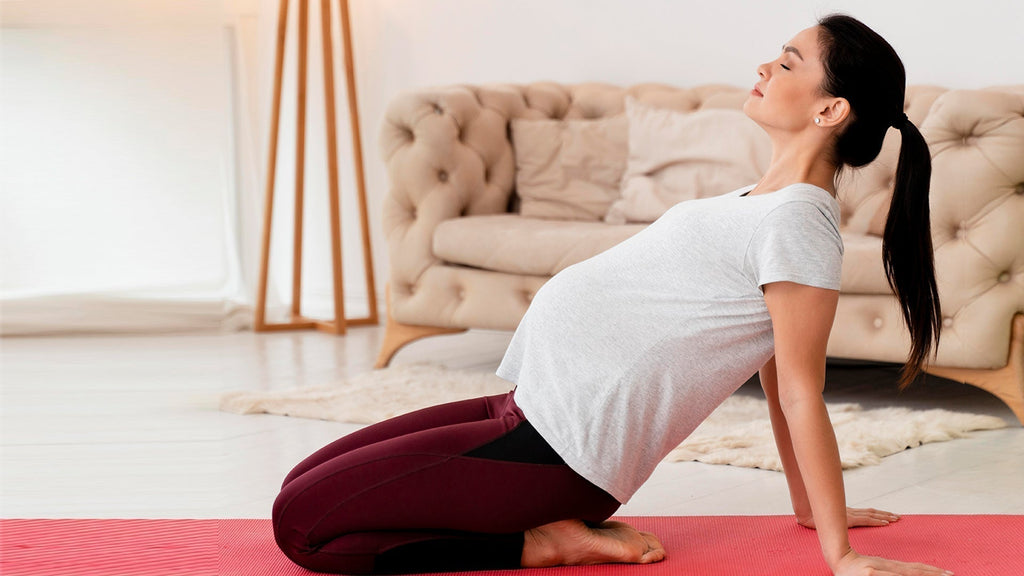
Prenatal Yoga and Its Benefits for Pregnant Women
Pregnancy is an amazing time, but let's be honest—it can also be pretty overwhelming. Between the backaches, swollen feet, and waves of emotions, your body is going through a lot. And as exciting as it is to feel your baby growing, the changes can sometimes leave you feeling tired and disconnected from yourself. Sound familiar?
That's where prenatal yoga comes in. Think of it as a gentle way to help your body adjust to pregnancy while also giving you a chance to relax and focus on yourself and your baby. Prenatal yoga isn't about twisting into impossible poses; it's designed especially for pregnant women, focusing on stretches and movements that help with all those pregnancy discomforts while keeping you calm and centered.
Let's explore the many benefits of prenatal yoga and why it's something every expecting mom should consider.
What is Prenatal Yoga?
Prenatal yoga is a type of yoga specifically designed for pregnant women to support their changing bodies and growing babies. It focuses on gentle stretches, breathing exercises, and relaxation techniques that are safe and beneficial during pregnancy. Unlike regular yoga, prenatal yoga avoids intense poses and focuses on movements that improve flexibility, strength, and balance, while also easing common pregnancy discomforts like back pain and swelling. Beyond the physical benefits, prenatal yoga helps moms-to-be stay emotionally balanced and calm, preparing both body and mind for labor and delivery.
Benefits of Prenatal Yoga:

Improves Flexibility and Strength
As your body grows and changes during pregnancy, it's natural to feel less flexible or stronger than usual. The growing baby puts extra strain on your muscles and joints, leading to discomfort in the back, hips, and legs. Prenatal yoga can help by gently stretching and strengthening the muscles you use most during pregnancy.
Yoga poses like cat-cow, warrior, and bridge pose are great for improving flexibility in your spine and hips, which can ease discomfort and help your body adjust to its new form. The strength gained through prenatal yoga also prepares your body for the physical demands of labour and delivery.
Reduces Pregnancy Discomfort
Aches and pains are part and parcel of pregnancy. Many women experience discomfort in their lower back, hips, and legs as their pregnancy progresses. Prenatal yoga can be an excellent way to alleviate some of this discomfort.
Gentle stretching and certain yoga poses help release tension in key areas of the body. For example, the cat-cow pose can ease back pain by stretching the spine, while the child's pose provides relief for your lower back and hips. Yoga can also improve circulation, which helps reduce swelling in your feet and ankles, a common complaint during the later stages of pregnancy.
Promotes Relaxation and Better Sleep
Pregnancy can sometimes lead to restless nights, especially as you get closer to your due date. It's not uncommon to feel anxious about the upcoming birth or simply uncomfortable with your changing body. Prenatal yoga is an effective way to manage stress and anxiety, helping you relax both mentally and physically.
Yoga incorporates deep breathing exercises, which are great for calming your mind and reducing tension. These breathing techniques are not only useful during your yoga sessions but can also help you relax before bedtime. This can result in better sleep quality, something every pregnant woman values.
Prepares You for Labor and Delivery
One of the most significant benefits of prenatal yoga is its ability to prepare your body for labour. Labour can be physically demanding, and being in tune with your body can make a big difference in how you manage contractions and pain.
In yoga, you learn to focus on your breathing, which can be incredibly helpful during labour. Controlled, deep breaths help you stay calm and relaxed, even when things get intense. Poses like squats and hip openers help strengthen the muscles you'll use during delivery while also improving flexibility in your pelvic area, which can make the birthing process smoother.
Encourages a Connection with Your Baby
Pregnancy is a time of great transformation, not just physically but emotionally. Prenatal yoga offers a space where you can slow down, breathe deeply, and connect with your growing baby. It's an opportunity to focus inward on the bond that's forming between you and your little one.
Many women find that the quiet moments during yoga, particularly during meditation or relaxation poses, allow them to truly tune into their bodies and feel more connected to their babies. This mindfulness can be a calming and grounding experience, helping you stay centered and focused during your pregnancy.
Builds a Supportive Community
Joining a prenatal yoga class isn't just good for your body and mind—it's also a great way to meet other pregnant women who are going through the same experience. Pregnancy can feel isolating at times, especially if you're dealing with challenges like nausea or fatigue, but being part of a yoga class can create a sense of community and support.
Having a group of women to share your journey with can provide emotional comfort, whether it's swapping tips, sharing stories, or simply having someone who understands what you're going through. Many moms-to-be form lasting friendships through prenatal yoga, making it an even more rewarding experience.
Conclusion
Prenatal yoga offers countless benefits, both physically and emotionally, for expecting mothers. But it's more than just a series of poses and breathing exercises—it's about making space for yourself and your baby during this unique time in your life. As you move through pregnancy, yoga can help you stay grounded, improve your physical health, and prepare for the incredible journey of motherhood.
One of the great things about prenatal yoga is that it can be adapted to your needs, whether you're just starting out or have been practising for a while. It's also a fantastic way to build a routine that you might carry into postpartum life, where gentle movement and mindfulness continue to play a big role in your well-being.
So, if you haven't tried it yet, consider giving prenatal yoga a go. Whether you join a class or practice at home, remember that this time is about nurturing both your body and mind. And who knows? You might find that it becomes a valuable part of your pregnancy journey and beyond!
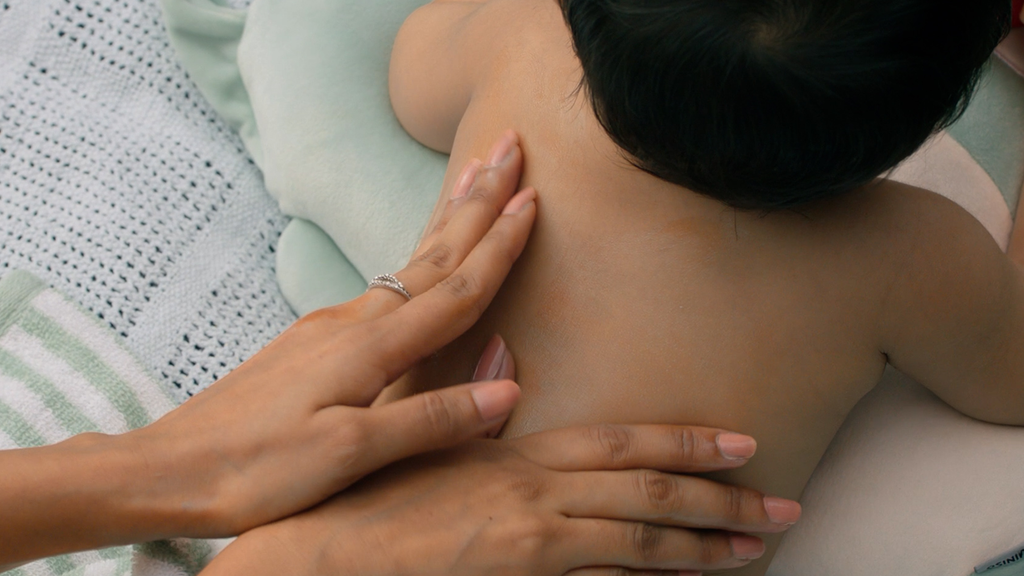
Essential Oils Benefits for Babies: A Complete Guide for ...
The arrival of a newborn is a beautiful and transformative experience that inspires you to seek the best ways to care for your precious bundle of joy.
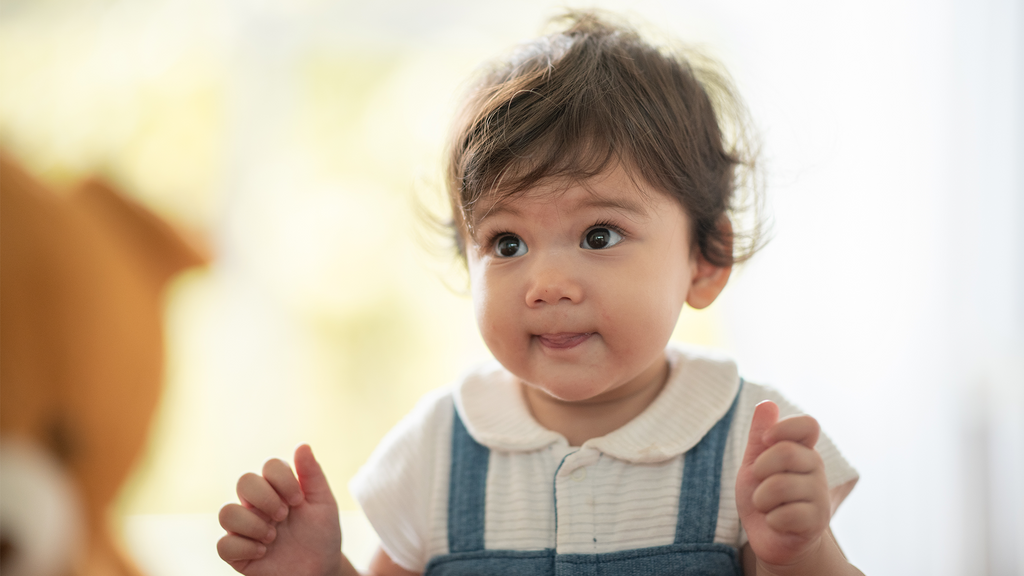
Best Ways to Get Rid of Mosquitoes This Monsoon
Monsoon brings the refreshing smell of rain, cooler temperatures, and beautiful greenery. But along with all this goodness comes something not so pleasant – mosquitoes. These tiny pests are more than just annoying; they can also carry serious diseases like dengue, malaria, and chikungunya. And if you have infants or young kids at home, the concern is even greater. Keeping them safe from mosquito bites becomes a top priority. But don't worry! In this blog, we'll explore the best ways to get rid of mosquitoes this monsoon, focusing on safe and effective solutions for everyone, especially your little ones.

-
Use Natural Mosquito Repellents
One of the safest ways to protect your baby from mosquitoes is by using a mosquito repellent for infants that is free from harmful chemicals. Mosquito repellents come in various forms – sprays, creams, and patches. However, choosing the right one for your little one is crucial. Look for natural options that use plant-based ingredients. For instance, Baby Forest's Mashak Kawach Baby Mosquito Repellent Spray is a great choice. It's made from a 100% natural blend of essential Ayurvedic herbs like Bhustarah (Lemongrass oil), Cedarwood, and Lavender Oil, which create a protective layer over your child's skin without any harmful chemicals. This ensures your baby is safe from both mosquito bites and harsh toxins.
-
Keep Your Home Mosquito-Free
It is important that you keep mosquitoes out of your home, especially during monsoon when they breed rapidly in stagnant water. Simple preventive measures can go a long way in controlling mosquito populations inside your house:
-
Use window and door screens:
You can simply start by making sure that all the windows and doors have proper screens to keep mosquitoes out while letting fresh air in. -
Mosquito nets:
If your child sleeps in a crib or bed, consider using a mosquito net. This physical barrier is highly effective, especially for protecting infants during sleep. -
Natural repellents at home:
You can place natural mosquito-repelling plants like basil, citronella, and lemongrass around your house. These plants are known to repel mosquitoes and add a touch of greenery to your home.
-
Remove Stagnant Water
Mosquitoes love stagnant water, and the monsoon season often leaves puddles and waterlogged spots around our homes, making it the perfect breeding ground for them. So, what can you do? First, empty out any containers, pots, or buckets that might be collecting water outside. Even small things like plant saucers, birdbaths, or old tires can turn into mosquito breeding spots if left unchecked.
Also, take a look around your home to fix any drainage issues. Clogged drains or broken pipes can cause water to pool up, which is exactly what mosquitoes are looking for. If you store water, make sure it's tightly covered to keep mosquitoes out.
-
Dress Your Baby in Protective Clothing
With other measures, you can also dress your baby in the right kind of clothing to keep the mosquitoes away. Pick one that is light-coloured and loose-fitting with long sleeves and pants, as these create a physical barrier between mosquitoes and your baby's skin.
-
Use Mosquito Traps and Zappers
Electronic mosquito zappers and traps are great for cutting down the number of mosquitoes inside your home. By placing them near windows or other entry points where mosquitoes tend to enter, you can noticeably reduce their numbers indoors and create a safer, mosquito-free environment for your family.
-
Essential Oils for Mosquito Control
Essential oils such as eucalyptus, tea tree, citronella, and lavender are known for their mosquito-repelling properties. These oils can be used in a diffuser, mixed with water, and sprayed around your home. Since essential oils are natural, they are a safer option for homes with infants. However, always ensure the oils are properly diluted and avoid using them directly on your baby's skin without consulting a pediatrician.
-
Safe Outdoor Protection
If you are planning to spend time outdoors with your baby during the monsoon, whether it's for a walk or playtime in the park, it's important to take extra precautions. Always apply a mosquito repellent for infants, which offers safe protection with its natural ingredients. Combine this with the use of a mosquito net on strollers or carriers to protect your baby while outside.
-
Maintain Hygiene Around Your Home
Cleanliness plays a major role in reducing mosquito populations. Dispose of garbage regularly and ensure waste bins are always covered. Trim overgrown bushes or plants near your home, as these areas can become breeding spots for mosquitoes.
Conclusion
Monsoons can bring more mosquitoes, but with a few simple precautions, you can keep your baby safe and comfy all season long. Using a mosquito repellent for infants, like Baby Forest's Mashak Kawach Baby Mosquito Repellent Spray, and taking steps around your home to prevent mosquito breeding are great ways to minimize exposure.
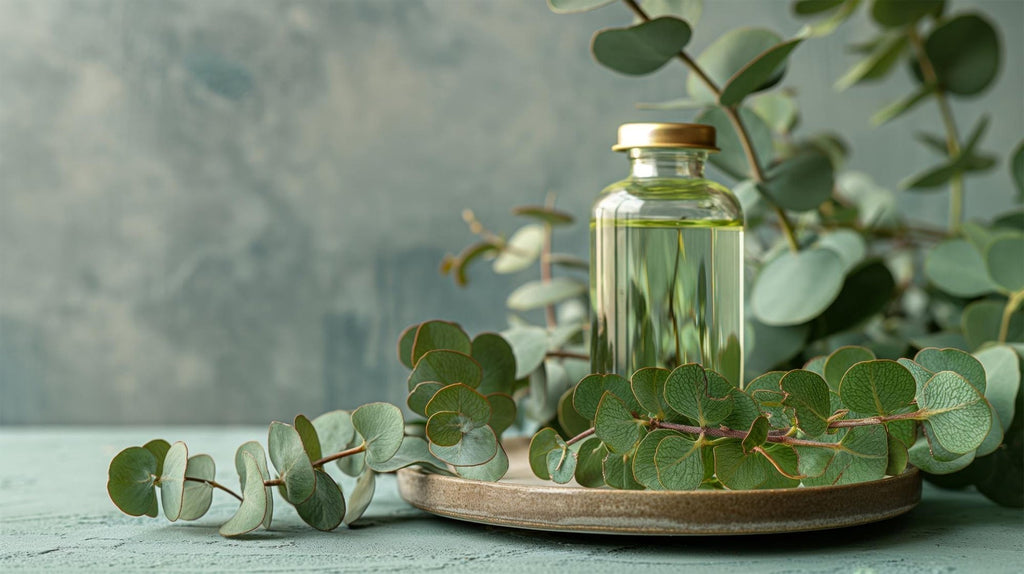
Benefits of Eucalyptus Oil in Baby Products: A Natural Ch...
Eucalyptus oil has been cherished for centuries for its healing and soothing properties. It’s a natural remedy often used in various health and wellness products. But did you know it can also be beneficial for your baby? In this blog, we’ll explore the benefits of eucalyptus oil for babies.
Eucalyptus oil infused products offer natural solutions and are gentle and safe for your little one.
What is Eucalyptus Oil?
Eucalyptus oil is extracted from the leaves of the eucalyptus tree. It is known for its refreshing scent and medicinal properties. This essential oil is often used in aromatherapy and is a popular ingredient in many natural health products. Eucalyptus oil can be a safe option for babies when used correctly and in appropriate amounts.
Instead of using the oil directly, it’s often more effective and safer to use products that incorporate eucalyptus as an ingredient. This ensures the oil is diluted to the right concentration, making it gentle enough for your baby’s delicate skin and sensitive system. Many baby products, such as vapor rubs and natural floor cleaners, include eucalyptus oil for its therapeutic benefits while ensuring it’s safe for everyday use. Let’s explore some of these benefits in more detail.
Benefits of Eucalyptus Oil in Baby Vapor Rubs
When your baby has a cold or feels congested, it can be really tough to see them uncomfortable. Baby vapour rubs containing eucalyptus oil can be a gentle and effective way to help relieve this discomfort.
-
Natural Decongestant
Eucalyptus oil acts as a natural decongestant. When applied to the chest or back, the soothing vapours can help to clear your baby’s nasal passages, making it easier for them to breathe. This is especially useful during colds or flu. -
Promotes Relaxation
The calming scent of eucalyptus oil can help your baby relax and sleep better. This is particularly helpful when your baby is restless due to illness. -
Safe for Sensitive Skin
Baby vapour rubs that contain eucalyptus oil are typically formulated to be gentle on sensitive skin. They are usually free from harsh chemicals, making them safer for your baby. -
Boosts Immunity
Eucalyptus oil is known for its antimicrobial properties. Products containing this oil can help protect your baby from germs and bacteria, boosting their immunity.
Eucalyptus Oil in Natural Floor Cleaners
When you have a baby, keeping the home clean is a top priority. Babies spend a lot of time on the floor, crawling and playing, so it’s important to ensure that the surfaces are free from harmful chemicals. This is where natural floor cleaners with eucalyptus oil come in.
-
Natural Disinfectant
Eucalyptus oil is a powerful disinfectant. It can effectively kill bacteria and viruses on surfaces when used in floor cleaners. This ensures that your baby is crawling on clean and safe floors. -
Safe for Babies
Unlike conventional floor cleaners that may contain harsh chemicals, natural floor cleaners with eucalyptus oil are free from toxins. This makes them safe for your baby to be around, reducing the risk of allergies or skin irritation. -
Pleasant Aroma
The fresh scent of eucalyptus oil leaves your home smelling clean and natural. It’s a great alternative to synthetic fragrances that can sometimes be overwhelming or irritating.
How to Use Eucalyptus Oil-Based Baby Products Safely?
While eucalyptus oil has many benefits, it’s important to use it safely, especially with babies.
-
Choose Baby-Specific Products
Always choose products that are specifically designed for babies. These products contain the right concentration of eucalyptus oil, ensuring that they are safe for your little one. -
Patch Test
Before using any new product on your baby, it’s a good idea to do a patch test. Apply a small amount of the product on a small area of your baby’s skin to check for reactions. -
Follow Instructions
Always follow the instructions on the product label. Use the recommended amount and avoid applying it too close to the baby’s face, especially around the eyes and nose. -
Consult Your Pediatrician
If you’re unsure about using eucalyptus oil products on your baby, consult your paediatrician. They can provide guidance based on your baby’s health and needs.
Additional Benefits of Eucalyptus Oil
Eucalyptus oil offers more than just respiratory and cleaning benefits. Here are a few more reasons to consider eucalyptus oil in your baby products:
-
Insect Repellent
Eucalyptus oil can act as a natural insect repellent. Products containing this oil can help keep mosquitoes and other insects away from your baby. -
Supports Respiratory Health
In addition to vapour rubs, eucalyptus oil can also be found in humidifiers and diffusers. These devices can help maintain healthy respiratory function by keeping the airways clear.
Eucalyptus oil is a natural, effective, and safe ingredient to include in baby products. Remember to always use these products as directed and consult your paediatrician if you have any concerns. Your baby deserves the best, and natural choices like eucalyptus oil are a step in the right direction.

Must-Have Baby Essentials for a Safe and Comfortable Monsoon
The monsoon season brings with it a refreshing break from the heat, but it also introduces new challenges for parents of young babies. High humidity, increased moisture, and cooler temperatures can affect your baby's comfort and health. Preparing with the right baby essentials can make a big difference in ensuring your little one stays safe and comfortable during the rainy season. Here's a detailed guide on must-have baby products for a safe and comfortable monsoon.

Essential Baby Products for this Monsoon
Talc-Free Baby Powder
During the monsoon, the increased humidity can cause your baby to sweat more, which can lead to heat rashes and discomfort. A talc-free baby powder is essential to keep your baby's skin dry and prevent rashes. The Dulaar Pyar Baby Powder is made from natural ingredients like corn starch and oats kernel, which are gentle on your baby's delicate skin. This talc-free powder helps absorb excess moisture and reduce friction, keeping your baby's skin smooth and dry throughout the humid season.

Baby Vapour Rub
Monsoon weather often brings cooler temperatures and can exacerbate colds and respiratory issues in babies. A baby vapour rub is a must-have during this monsoon. The Komal Shwaas Baby Vapour Rub is formulated for infants and contains natural ingredients like eucalyptus and lavender oils. These ingredients help relieve nasal congestion, making breathing comfortably easier for your baby. Apply a small amount on your baby's chest, back, and soles of their feet before bedtime to help them sleep better during cold and damp nights.

Baby Rash Healing Cream
Wet weather and frequent diaper use can increase the likelihood of diaper rashes. A baby rash healing cream must be on hand during monsoon. Baby Forest’s Komal Kawach Diaper Rash Healing Cream contains Kusha, Harachampaka Madanah, and Geranium oil that creates a protective layer and keeps the baby’s skin soft, dry and supple. It also includes soothing ingredients like Aloe Leaf Juice and Jojoba oil. Regularly applying a rash cream can prevent rashes from developing and ensure that any existing rashes heal quickly.

Natural Floor and Baby Toy & Surface Cleaner
Monsoon season often brings mud and dirt indoors, increasing the risk of germs and bacteria that can affect your baby's health. A natural floor cleaner and, a baby toy & surface cleaner are vital for keeping your home clean and safe for your baby. The Swaksh Bhoomi Natural Floor Cleaner is made from natural, non-toxic ingredients, ensuring your baby is not exposed to harsh chemicals. This cleaner disinfects floors and surfaces, providing a hygienic environment for your baby to crawl and play safely. Similarly, the Swaksh Khilone Baby Toy & Surface Cleaner is designed to keep toys and surfaces free from germs, using non-toxic ingredients. Regular use of these cleaners helps maintain hygiene and reduces the risk of infections, especially during the monsoon when mold and mildew can thrive.

Pashmina Baby Blanket
Keeping your baby warm and cozy during the cooler monsoon months is important. A Pashmina baby blanket is an excellent choice for this purpose. Our Kashmiri Pashmina Baby Blanket is made from incredibly soft pashmina wool, which is lightweight and provides excellent insulation. These blankets are perfect for wrapping your baby during naps or bedtime, offering warmth without overheating. Pashmina blankets are also breathable, preventing your baby from getting too hot and ensuring they stay comfortable. Its luxurious feel makes them a comforting and soothing choice for your baby.

Baby Swaddles
Swaddling helps babies feel secure and improves their sleep quality, which is especially beneficial during the monsoon when the weather can be unpredictable. Baby swaddles made from soft, breathable fabrics like cotton or muslin are ideal. The Komal Aavran Baby Swaddle is made from soft, breathable fabric that helps regulate your baby's body temperature, preventing overheating while keeping them snug. Swaddling can also reduce the startle reflex, which often wakes babies up.

Baby Towel
When it comes to keeping your baby dry and comfortable after baths, the Somya Aanchal Baby Towel is an excellent choice. This towel offers exceptional absorbency and softness, made with a blend of 60% zero-twist cotton and 40% bamboo. The hooded design adds a touch of cuteness and ensures your baby's head stays warm, which is especially important during the cooler monsoon months. Generously sized for ample coverage, this towel is gentle on your baby's delicate skin and provides the ultimate comfort after bath time.

Additional Tips for a Safe and Comfortable Monsoon
-
Maintain a Clean Environment
Regularly clean your baby's room and play areas to prevent mold and mildew, which thrive in humid conditions. -
Dress Appropriately
Dress your baby in lightweight, breathable clothing to prevent overheating. Layering is a good strategy, as you can easily add or remove layers based on the temperature. -
Monitor Humidity Levels
Use a dehumidifier to control indoor humidity levels. High humidity can cause discomfort and promote the growth of mold and bacteria. -
Stay Dry
Ensure your baby stays dry by promptly changing clothes and diapers. Wetness can cause skin irritation and rashes.
Preparing for the monsoon season with the right baby products can significantly improve your baby's safety and comfort. Each item plays a crucial role in addressing the unique challenges of the rainy season, from talc-free baby powder to keep their skin dry to a pashmina baby blanket for warmth. Incorporating these products into your daily routine will help you easily navigate the monsoon, keeping your baby happy, healthy, and comfortable. Remember, the key to a stress-free monsoon is preparing and choosing high-quality products catering to your baby's needs.
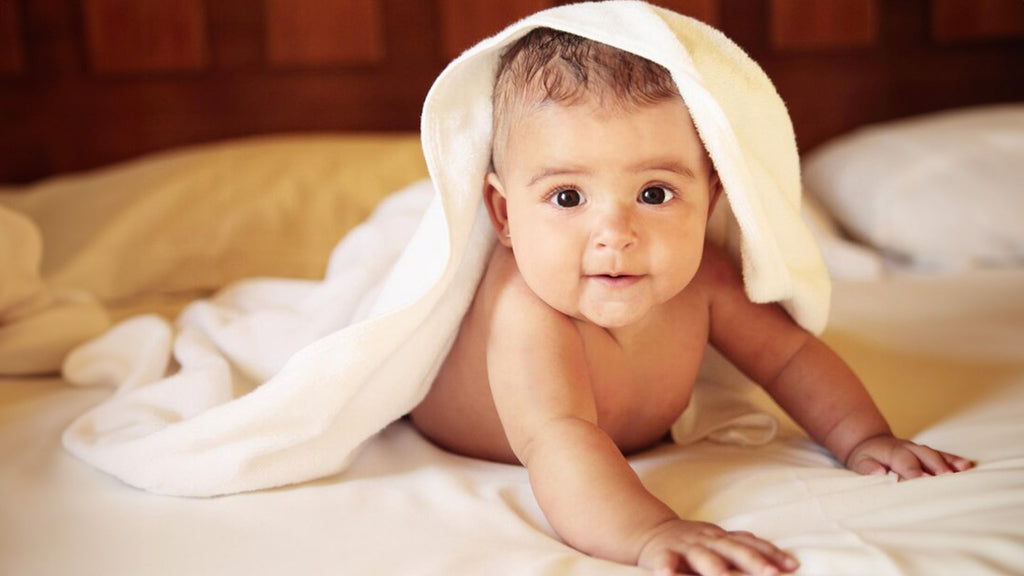
Buying a Baby Towel? Here’s what you need to know!
Choosing the right baby towel is essential for your baby's comfort and hygiene. With so many options available, it can be overwhelming to decide which towel is best for your little one. In this guide, we'll explore the key factors to consider before purchasing a baby bath towel, ensuring you make an informed decision that keeps your baby warm, dry, and comfortable.
Factors to Consider While Purchasing a Baby Bath Towel:
Soft and Comfortable
One of the most important features to look for in a baby towel is its softness. A soft bath towel for a baby is gentle on your baby's delicate skin, reducing the risk of irritation and discomfort. Babies have much more sensitive skin than adults, so using a towel that is soft and plush can make bath time a pleasant experience.
When shopping for a baby bath towel, consider the material. Towels made from natural fibres like cotton are usually softer and more comfortable. A cotton towel for a baby is an excellent choice because it is not only soft but also breathable, ensuring your baby's skin stays healthy and free from rashes.
Highly Absorbent
The primary function of a towel is to dry, so it's crucial to choose a baby towel that is highly absorbent. After a bath, you want to be able to dry your baby quickly and efficiently to prevent them from getting cold. Look for towels that are thick and have a high absorbency rate, as these will soak up moisture effectively.
Materials like cotton and bamboo are known for their excellent absorbency. A blend of these materials can offer superior performance. For instance, our baby towel combines 60% zero-twist cotton, and 40% bamboo providing exceptional absorbency, making it ideal for drying your baby quickly after a bath.
Eco-Friendly
In today's world, making eco-friendly choices is more important than ever. When selecting a baby bath towel, consider the environmental impact of the product. Towels made from organic cotton or bamboo are great eco-friendly options. These materials are sustainable and biodegradable, reducing your environmental footprint.
Organic cotton is grown without harmful pesticides and chemicals, making it safer for your baby and better for the environment. Bamboo is another excellent choice as it grows quickly without the need for fertilizers or pesticides. Choosing an eco-friendly cotton towel for your baby not only benefits the planet but also ensures that your baby's skin is not exposed to harmful substances.
Durable
Durability is another crucial factor to consider when buying a baby towel. Babies can be messy, and their towels will need frequent washing. A durable towel will withstand repeated laundering without losing its softness or absorbency.
High-quality towels made from strong fibers like cotton and bamboo are more likely to remain in good condition over time. Investing in a durable soft bath towel for your baby means you won't have to replace it frequently, saving you money in the long run.
Hooded Towel for Baby
A hooded towel for the baby adds an extra touch of practicality and cuteness to bath time. The hood helps keep your baby's head warm after a bath, which is especially important for young babies who can lose heat quickly. A hooded towel also makes it easier to wrap and dry your baby, ensuring they stay snug and comfortable.
Hooded towels come in various designs and sizes, so you can choose one that best fits your baby's needs. The hooded design not only looks adorable but also provides additional warmth and coverage, making it a must-have item for bath time.
Why Choose Somya Aanchal Baby Towel?
Choosing the Somya Aanchal Baby Towel ensures you're providing your baby with the best in comfort, absorbency, and eco-friendliness. This towel stands out because it combines the softness of 60% zero-twist cotton with the sustainability of 40% bamboo, making it exceptionally gentle on your baby's delicate skin. The generous size offers ample coverage, keeping your baby warm and cosy after bath time. The hooded design not only adds an adorable touch but also provides extra warmth for your baby's head. Additionally, the high absorbency of the Somya Aanchal Baby Towel ensures quick drying, making it an essential item for every new parent who values quality and practicality.

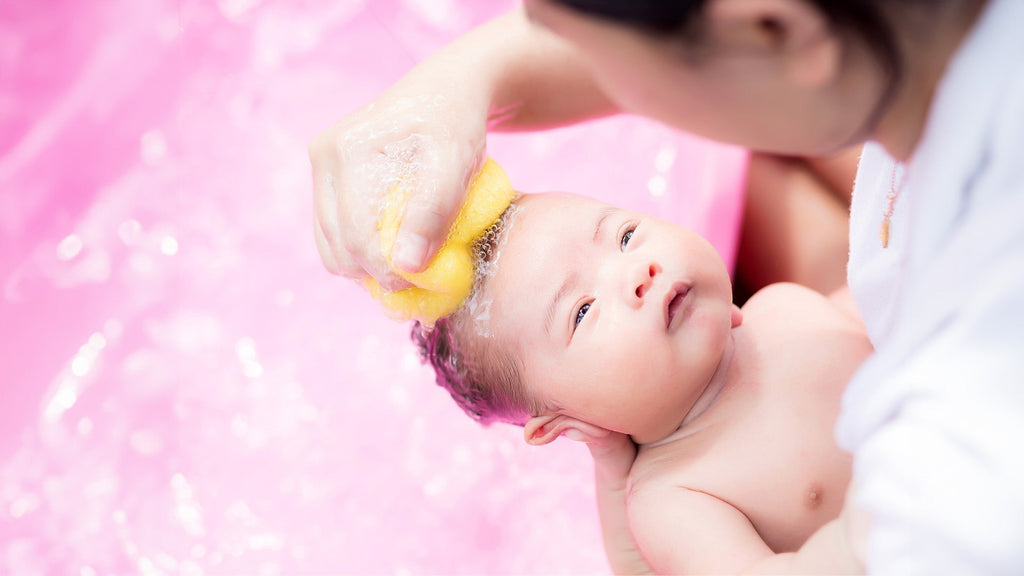
A Comprehensive Guide to Wash Your Baby’s Hair
Washing your baby’s hair might seem daunting, especially for new parents. However, with the right techniques and products, it can be a gentle and enjoyable experience for you and your baby. This guide will provide detailed steps on how to properly wash your baby’s hair, ensuring their scalp remains healthy, and their hair stays soft and clean.
Why Washing Your Baby’s Hair is Important
Regularly washing your baby’s hair is essential for several reasons:
-
Hygiene
It helps to remove dirt, sweat, and excess oils that can accumulate on the scalp. -
Comfort
A clean scalp reduces the likelihood of itchiness and discomfort. -
Health
Proper washing can prevent conditions like cradle cap, a common infant scalp issue.
How Often Should You Wash Your Baby’s Hair?
The frequency of washing your baby’s hair depends on their age and hair type:
-
Newborns
For newborns, washing their hair once or twice a week is sufficient since they don’t produce much oil. -
Older Babies and Toddlers
As your baby grows and becomes more active, you might need to wash their hair 2-3 times a week or as needed.
Choosing the Right Baby Shampoo
Selecting the right shampoo is crucial for maintaining your baby’s hair and scalp health. Here’s what to consider:
-
Gentle Formula
Opt for baby shampoos that are specifically formulated for babies. These are usually tear-free and mild, avoiding harsh chemicals that can irritate the scalp. -
Organic Baby Shampoo
Organic baby shampoos are an excellent choice as they are free from synthetic fragrances, dyes, and harmful chemicals. They often contain natural ingredients like aloe vera, coconut oil, and neem extract, which are soothing and nourishing for your baby’s delicate scalp.
Why Choose Organic Baby Shampoo?
-
Safe Ingredients
Organic baby shampoos are made from natural, safe ingredients less likely to cause allergic reactions or skin irritation. -
Eco-Friendly
These products are produced using environmentally friendly practices and are biodegradable, reducing their environmental impact. -
Nourishing
Natural organic shampoo ingredients can nourish your baby’s hair and scalp, promoting healthy growth.
Preparing for the Hair Wash
Before you start washing your baby’s hair, gather all necessary supplies to ensure a smooth process:
-
Baby Shampoo
Choose a gentle or organic baby shampoo. -
Soft Washcloth or Sponge
For gentle cleansing. -
Cup or Rinse Bottle
For pouring water over your baby’s head. -
Towel
A soft, absorbent towel for drying your baby’s hair.
Steps to Properly Wash Your Baby’s Hair
1. Create a Calm Environment:
Choose a warm, comfortable room for the bath. Make sure you have everything within arm’s reach to avoid leaving your baby unattended.
2. Support Your Baby’s Head:
Gently cradle your baby’s head with one hand while supporting their body with the other. You can either hold them in your arms or lay them on a padded surface like a bath cushion or a sink insert.
3. Wet Your Baby’s Hair:
Using a cup or rinse bottle, gently pour warm water over your baby’s head. Ensure the water is at a comfortable temperature (around 37-38°C or 98-100°F).
4. Apply Shampoo:
Squeeze a small amount of baby shampoo onto your hand and gently massage it into your baby’s scalp using your fingertips. Be gentle to avoid causing any discomfort. Focus on the scalp rather than the hair itself, as the scalp is where oils and dirt accumulate.
5. Rinse Thoroughly:
Rinse your baby’s hair thoroughly with warm water, ensuring all the shampoo is washed away. Residual shampoo can cause irritation or dryness.
6. Dry Gently:
Wrap your baby in a soft, absorbent towel and gently pat their hair dry. Avoid rubbing, as this can damage their delicate hair and scalp.
Tips for a Stress-Free Hair Washing Experience
Make It Fun:
Turn hair washing into a fun activity by singing songs, talking to your baby, or using bath toys to distract them.
Be Consistent:
Establish a routine so your baby knows what to expect. Consistency can make the process smoother and less stressful over time.
Be Patient:
Your baby might not enjoy hair washing at first, but with patience and gentle handling, they will gradually get used to it.
Use Minimal Products:
Babies have sensitive skin, so it’s best to use minimal products. Stick to a gentle shampoo and avoid using conditioner or other hair products unless necessary.
Handling Common Challenges
Cradle Cap
If your baby has a cradle cap (a common condition characterized by flaky, crusty patches on the scalp), you can gently massage a bit of baby oil onto the scalp before shampooing. This helps to loosen the flakes. Use a soft brush to gently remove the flakes during shampooing.
For more information on cradle cap, you can read this detailed guide - Dealing with Cradle Cap: Causes, Treatment Options, and Proactive Prevention
Fear of Water
Some babies are afraid of water being poured over their heads. To minimize discomfort, pour water slowly and shield their eyes with your hand. Using a rinse bottle with a spout can help direct the water flow more precisely.
Sensitive Scalp
If your baby has a particularly sensitive scalp, consult your pediatrician before using any new products. They might recommend a specific shampoo or provide additional care tips.
Properly washing your baby’s hair is an important part of their hygiene routine. By choosing the right products, such as organic baby shampoo, and following gentle techniques, you can ensure that hair washing is a comfortable and enjoyable experience for both you and your baby. Remember, patience and consistency are key to making hair washing a smooth part of your baby’s bath time. With these tips, you can keep your baby’s hair clean, healthy, and happy.

Shishu Abhyanga Guide: Benefits of Baby Oil Massage
Shishu Abhyanga or Baby Oil Massage, is an ancient Ayurvedic tradition widely practiced in India among new parents. It is well-known that regular oil massage has many benefits for a baby. Infant’s skin is delicate and sensitive; therefore, daily oil massage can promote healthy skin, provide relief from dryness, and hydrate skin to keep your baby protected. In addition to this, your baby will have increased blood circulation, strengthening the immune system and enhancing physical development. Hence, baby massage is a ritual that promotes physical, mental, and emotional well-being and can be performed daily to promote strong bonding between mother and child.
We’ve put together a baby massage guide featuring simple step-by-step instructions so that anyone can easily practice this ancient Ayurvedic tradition at home. Before starting a massage, you must take some precautions as described below:
Precautions:
- Abhyanga should be done preferably in the morning.
- Use a clean sheet while giving a massage.
- Use a slightly warm oil for giving a baby massage. Take a few drops on your palm before applying to your baby’s skin to avoid skin burn.
- Do not give a massage on a full stomach as sudden aspiration can occur. If the baby has been fed, it is best to wait for an hour before the massage.
- The pressure should be gentle to moderate.
- Massage must be done with clean hands and nails. You must trim the nails to avoid causing any harm to the baby’s skin.
- Make sure oil is not in contact with the baby’s eyes.
- Use caution when holding and massaging the baby to avoid falls and injuries.
- Babies should always be kept warm & well covered after Abhyanga.
Step By Step Process to Give Shishu Abhyanga:
Baby oil massage can be one of the best ways to bond with your baby. Not only does it help you to connect with your baby, but it also helps to relax them, making it easier for both of you to fall asleep at night. However, performing a massage can be difficult when you have never done one before. Here is a step-by-step process to give your baby a massage using baby oil in simple steps:
Step 1: Get Your Baby Ready
The first thing you must do is get your baby ready for their massage. You should make them feel comfortable and relaxed, so make sure that they are wearing something soft and comfortable, such as a t-shirt or onesie. It is also important that the room is warm enough, so check the room temperature on your thermostat to ensure that it is comfortably warm for your baby.
Step 2: Prepare the Area
You will need ample area to give Shishu Abhyanga. The bed, floor, or changing table are good options. Then place a towel on the surface and lay your baby down. The towel will prevent you from getting baby oil on the beg or table, and it will also provide a comfortable, soft surface for your little one.
Step 3: Select Oil
Always select an unscented oil that’s safe for babies, such as mineral oil, coconut oil, or olive oil. You can give a massage with Baby Forest Maasoom Maalish baby body massage oil. This oil is a mishran of 10 Ayurvedic natural essential oils of herbs, flowers, nut oils, and medicinal plants that are good for baby skin.
Pour some onto your hands and rub them together to warm it up before you start massaging your baby’s body.
Step 4: Lower Body Massage
Slowly massage heels and toes with firm, gentle strokes. Hold baby by one hand at all times. Then massage the leg from ankle to thigh and from hip to hip. Smoothly massage the leg for several minutes. It is recommended to do this on both legs simultaneously. Do not rub the genital area.
Step 5: Upper Body Area
Massage the upper back by placing both hands in the downward direction from shoulders to waist. After that, massage each arm separately. Start from the wrist up to the shoulder by making circular motions with the fingers and palms of hands. Repeat this process for another arm also.
Step 6: Back Massage
After massaging the front of your baby’s body, turn them onto their tummy and massage them from head to toe. Make sure your touch is soothing. Take a pause if you feel your baby is uncomfortable.
Step 7: Face Massage
Massage the baby’s face with your finger pads. You should begin at the middle of the forehead, down the outer side of the baby’s face, and then in toward the cheeks. Gently massage the scalp in small circular motions.
When to Perform Abhyanga Properly
Abhyanga, or Ayurvedic oil massage, can be introduced to newborns after their umbilical cord stump has healed, typically around 10-14 days old. The best time to perform Abhyanga is before a bath, ideally in the morning or early evening when the baby is calm and alert. Ensure the room is warm and draft-free to keep the baby comfortable. Abhyanga can be done daily or several times a week, depending on the baby's skin type and routine. It is essential to observe the baby's response to the massage and adjust the frequency and duration accordingly to ensure a positive and soothing experience.
Benefits of Shishu Abhyanga
Shishu Abhyanga, or infant massage, offers numerous benefits for both the baby and the caregiver. It promotes better sleep patterns and helps in the development of the baby's nervous and immune systems. Regular massage can improve blood circulation, support healthy skin, aid in digestion, and reduce colic and gas. Additionally, Shishu Abhyanga strengthens the bond between the baby and the caregiver, providing a sense of security and comfort through physical touch. The gentle massage also helps in the overall growth and development of the baby, contributing to a calm and happy demeanor.

Which Baby Body Wash Is Right for Your Little One?
Body washes are a convenient and soothing way to cleanse your baby's delicate skin. Unlike traditional soaps, which can be drying, and harsh, organic body washes are formulated to be mild and moisturizing, making them a great choice for daily use. Choosing the right baby body wash is crucial because their skin is much more sensitive than adult skin. With countless options available, it can be overwhelming for new parents to find one that is safe, gentle, and nourishing. To simplify your decision, let's delve into the benefits of various natural ingredients found in baby body washes that are effective and gentle. Additional Tips for Bathing Your Baby e on your little one's tender skin.
Understanding Baby Skin
Baby skin is thinner and more susceptible to dryness and irritation compared to adult skin. This is why it's important to choose products specifically designed for babies — products that moisturize and protect without using harsh chemicals. A baby body wash with natural, soothing ingredients can help maintain the natural softness and health of your baby's skin.
Key Natural Ingredients to Look for in Baby Body Washes
When selecting a baby body wash, look for these natural ingredients known for their skin-friendly properties:
-
Jaee Giri (Oat Kernel)
Known for its soothing properties, oat kernel is excellent for baby's sensitive skin. It helps to calm irritation and is incredibly moisturizing, making it perfect for keeping your baby's skin soft and well-hydrated. -
Narial Tailam (Coconut Oil)
Coconut oil is a wonderful moisturizer and is known for its antibacterial and antifungal properties. It's gentle enough for daily use on baby's skin and helps in treating and preventing diaper rash. -
Methika (Fenugreek Leaf)
Fenugreek has natural anti-inflammatory properties that can soothe a baby's skin. It is beneficial for combating cradle cap and eczema. -
Watermelon
Rich in vitamins and water content, watermelon is a hydrating ingredient that keeps the baby's skin fresh and radiant. -
Parijata (Jasmine Oil)
Known for its calming and soothing effects, jasmine oil can help in relaxing your baby, making bath time a more pleasant experience. -
Amalaka (Indian Gooseberry)
A powerhouse of antioxidants, Indian gooseberry helps protect the skin from environmental damage and promotes healthier skin. -
Karpurapuspa (Chamomile)
Chamomile is another ingredient renowned for its soothing properties. It's especially good for babies with irritated or inflamed skin due to its anti-inflammatory benefits. -
Chandana (Red Sandalwood)
Often used in Ayurveda, red sandalwood can help cool and soothe the skin, making it ideal for use in baby body washes. -
Ghrit Kumari (Aloe Vera)
Aloe vera is hydrating and soothing and works well to treat and prevent dry skin patches and diaper rashes. -
Madhukarkati (Grapefruit)
Known for its refreshing scent and cleansing properties, grapefruit is a natural astringent which helps keep your baby's skin clean and refreshed.
Buying the Right Baby Body Wash
When choosing a baby body wash, always opt for products free from parabens, sulfates, and artificial fragrances, which can irritate delicate skin. Look for tear-free products that are derma-safe. Reading product labels and choosing washes that list natural ingredients can help ensure that the product is gentle and safe for your baby.
Additional Tips for Bathing Your Baby
- Before bathing your baby, always remember to test the water temperature.
- Use a soft washcloth to gently apply the body wash.
- Keep bath time short, especially if your baby has very dry or sensitive skin, to avoid further drying out the skin.
- After bathing, gently pat your baby's skin dry with a soft towel and apply a mild moisturizer to retain moisture.
Choosing the right body wash for your baby is about finding a balance between gentle, effective cleansing and skin nourishment. With the right natural ingredients, you can ensure that your baby's skin remains healthy, hydrated, and happy. Remember, every baby is different, so what works for one may not work for another. Don't hesitate to consult with a pediatrician if you have concerns about choosing skincare products for your baby.
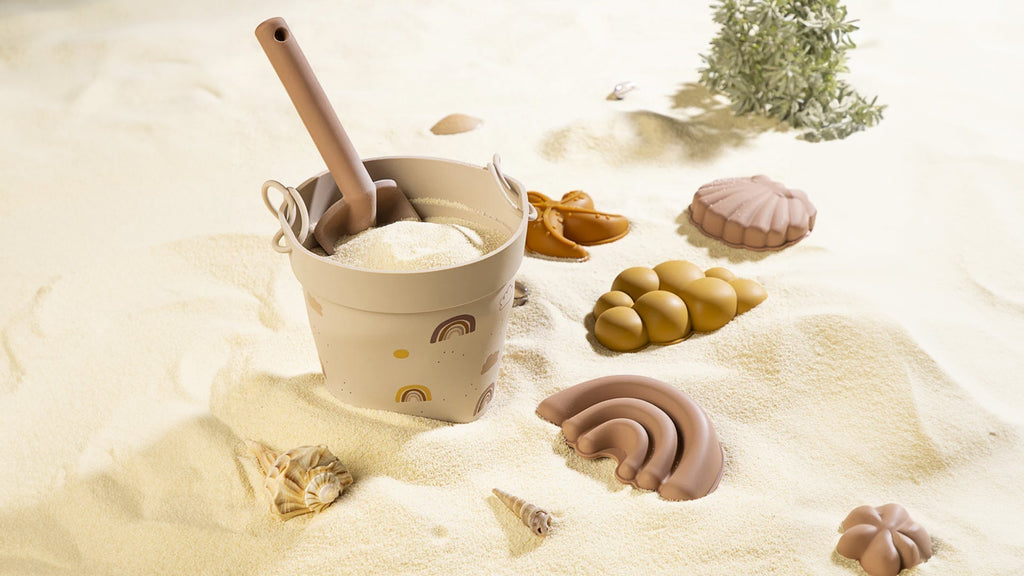
Essential Tips for a Perfect Beach Day with Kids this Summer
A beach day with kids can be a great way to spend the summer, but it takes careful planning to ensure everything runs properly. There are various factors to consider, like carrying the appropriate gear and keeping your children safe and entertained. This blog contains a few tips to help you have a fantastic beach day with your children.
Preparation is Key
Before you head to the beach, make a checklist of all the items you need to bring. Preparation ensures that you have everything necessary to keep your children comfortable, safe, and entertained. This includes beach toys, sun protection items, food, and drinks. It's always better to be over-prepared than to realize you've forgotten something crucial once you're already at the beach.
Sun Protection
One of the most important aspects of a beach day is protecting your kids from the sun. Young children have sensitive skin that is more prone to sunburn. Apply a broad-spectrum SPF30 baby sunscreen lotion to your child's skin about 30 minutes before sun exposure. Reapply every two hours or after swimming. Choose a sunscreen made exclusively for babies, ensuring that it is mild on their sensitive skin. Make sure your children are wearing wide-brimmed hats to shield their faces and necks from the sun. Setting up a beach umbrella or tent provides a shaded area where your kids can take a break from the sun. This is especially crucial during peak sunlight hours, which normally occur between 10 a.m. and 4 p.m.
Beach Toys and Entertainment
Keeping your kids entertained at the beach is crucial for a fun day. Bringing along the right beach toys can make a significant difference. The beach munchkin bucket is a versatile toy that can provide hours of entertainment. Your kids can use it to build sandcastles, collect seashells, or even catch small sea creatures. It's lightweight, portable, and ideal for beach trips. If your children enjoy swimming, inflatable toys and floaties are great additions. They can float on the water safely and have fun splashing around.
Baby Care Essentials
When spending a day at the beach with a baby, having the right baby care essentials is critical. Baby wipes are indispensable for cleaning up messes, wiping sandy hands, and even cooling down your baby's skin. Choose wipes that are gentle and free of artificial fragrance to avoid irritation. Talc-free baby powder is perfect for removing sand from your baby's skin. Sprinkle some powder on their skin and brush off the sand effortlessly. This simple trick can keep your baby comfortable and free from irritation. Keep your kids hydrated by offering water frequently. Pack healthy snacks like fruits, crackers, and sandwiches to keep their energy levels up throughout the day.
Appropriate Beachwear for Babies
Choosing the right beachwear for your baby is essential for their comfort and protection. A Hand Embroidered Gather Top with Underpants is a cute and stylish outfit that is perfect for a beach day. The lightweight fabric keeps your baby cool, while the hand embroidery gives a touch of elegance. The underpants provide coverage and keep the sand out. A full-sleeved baby bodysuit set offers excellent sun protection for your baby's delicate skin. Look for ones made from breathable materials that dry quickly. This outfit is perfect for cooler beach days or when you need extra sun protection. An overlapping baby bodysuit is simple to put on and remove, making diaper changes a quick game. The design ensures that your baby stays comfortable, and the soft fabric is gentle on their skin.
Safety Tips
Always keep a close eye on your kids, especially when they are near the water. Designate a responsible adult to supervise at all times. Teach your children basic water safety rules, such as not swimming alone and understanding the dangers of strong currents. Pack a simple first aid kit that includes bandages, antiseptic wipes, and other items you'll need to heal small wounds. Dehydration can occur quickly under the sun. Ensure your kids drink plenty of water and take breaks in the shade to cool down.
After the Beach
After a fun-filled day at the beach, there are a few things to keep in mind. Rinse off the sand and saltwater from your kids' skin and hair. Check your child's skin for any signs of sunburn. If you notice redness or irritation, apply aloe vera gel or a soothing lotion to ease the discomfort.
A beach day with kids can be a delightful and memorable experience with the right preparation and care. By ensuring proper sun protection, bringing the right toys, packing essential baby care items, and choosing appropriate beachwear, you can create a perfect beach day for your family. Remember to prioritize safety, stay hydrated, and engage your kids in fun activities. With these tips, you are well-equipped to enjoy a wonderful day at the beach with your little ones this summer.
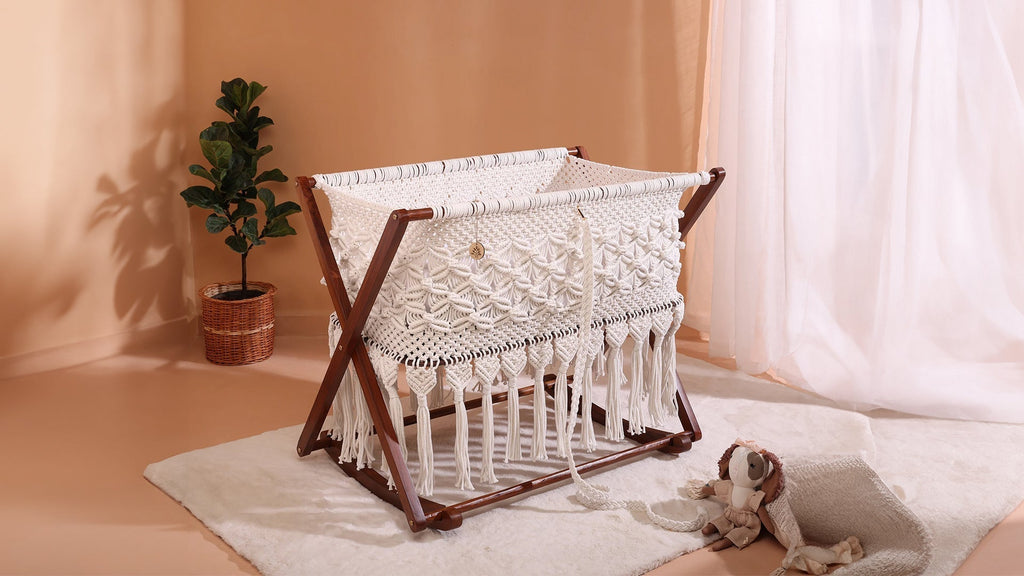
07 Things to Know Before You Buy a Baby Cradle in India
Buying a baby cradle is one of the most significant decisions for new parents, as it provides a safe and comfortable space for your little one to sleep. With various options available in the market, choosing the right cradle can be overwhelming. This guide will help you understand the essential aspects to consider before purchasing a baby cradle in India, ensuring you make an informed and thoughtful choice.
Importance of a Handmade Cradle
Handmade cradles are crafted with care and precision, often featuring unique designs and superior quality. Usually, these cradles are crafted by expert artisans who take great care to ensure both longevity and safety. A handmade baby cradle not only adds an aesthetic appeal to your baby's nursery but also provides a personal touch that mass-produced cradles lack. In India, handmade cradles are often made from natural materials like wood, which are safe and non-toxic for your baby.
Benefits of a Detachable Rocker
A detachable rocker is a valuable feature to look for in a baby cradle. The gentle rocking motion mimics the movements of a mother's arms, providing a sense of security and relaxation for your baby. This can be particularly soothing during nap times or when your baby is fussy. The ability to detach the rocker allows for versatility, as you can use the cradle as a stationary bed when needed. This feature ensures that the cradle can adapt to different situations and needs, making it a practical choice for parents.
Durability is Key
When buying a baby cradle, durability is a crucial factor to consider. You want a cradle that will last through your baby's early years and potentially be used for future siblings. Look for cradles made from sturdy materials like natural wood, which is known for its strength and longevity. A well-made cradle will endure normal wear and tear and give your child a secure place to sleep. Check for features like strong joints, smooth finishes, and stable bases to ensure the cradle's durability.
The Charm of Natural Wood
Natural wood cradles are a popular choice among parents due to their aesthetic appeal and safety. Wood is a durable and sturdy material that provides a stable sleeping environment for your baby. In addition, natural wood is suitable for young children because it doesn't contain any poisons or dangerous compounds. Wooden cradles also tend to have a timeless look, fitting seamlessly into various nursery themes and styles. Wood is also simple to keep and clean, so your baby's sleeping space will always be safe and hygienic.
Ease of Assembly
As a new parent, you'll appreciate a cradle that is easy to assemble. Look for cradles that come with clear instructions and all the necessary hardware. Choosing an easy-to-assemble cradle saves time and allows you to prioritize other duties. Additionally, an easy-to-assemble cradle can be conveniently moved and reassembled in different rooms as needed. This flexibility is especially beneficial in the early months, when you may want to keep your infant close at all times.
Value for Money
When investing in a baby cradle, it's important to consider the value of money. While it might be tempting to opt for the cheapest option, remember that a high-quality cradle will provide better safety, comfort, and durability. Consider the features, materials, and craftsmanship of the cradle to ensure you're getting the best value for your investment. A durable cradle can be used for several children and passed down to future generations, making it a good investment.
Baby Forest's macrame wooden baby cradle combines the beauty of handmade craftsmanship with the durability of natural wood. These cradles frequently contain complex macrame designs, which offer a sense of elegance to the nursery. The gentle, detachable rocking motion of a macrame wooden cradle mimics the soothing movements of a mother's arms, helping your baby feel secure and relaxed. Measuring approximately 36x36x20 inches, these cradles are ideal for babies up to 3 years of age, providing a comfortable and spacious sleeping area.
Related Read - A Guide to Creating the Perfect Sleep Space for Your Baby
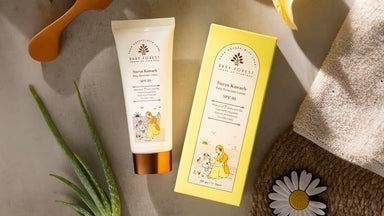
Here’s everything you need to know about Sun Protection F...
Babies are the happiness factor in a family when it comes to the family HQ (Family Happiness Quotient). With Summer at its peak, all parents must make sure that their baby must be sun protective at all times of the day. With so many options of sunscreens available in the market these days, it becomes a task to choose the best one for your little one. In this article, we get straight to the point and provide you with a well-elaborated overview of sunscreen usage for babies and all-around advantages for one’s health.
"Better a sun-kissed than sunburned!" This proverb has more relevance to baby skincare than anything else. Choosing the right baby sunscreen or sunblock, among other things, is an important step in the direction of security concerning the scorching summer heat & UV rays. Parents should look for more natural ingredients than chemicals when it comes to choosing the right sunscreen for their little ones.
Reading labels & making informed choices should be the goal of every parent before applying anything to their baby’s skin. The key requirement is a thorough understanding of the ingredients in the sunscreen and how they are aligned with the specifications for your baby’s skin. Alongside applying sunscreen, one must also ensure the baby is protected with a physical layer of clothing.
There is a very fine line between protecting the skin and protecting the skin with comfort. Organic cotton clothing ensures that the skin area is aerated to avoid overheating. Studies suggest that when using Sunscreen, one must dress the little ones in breathable clothing.
Understanding the concept of UV rays
The UV rays on earth are majorly of two types UVA & UVB rays. While UVA reaches the earth at about 95%, UVB reaches the rest at 5%. As mentioned, Sunlight is good for the baby, one must make sure that the baby is exposed to the morning sunlight only for a reason (The morning UV rays are UVB(generally good for the skin). UVB rays delay tanning & don’t age skin cells. When it comes to the Sun Protection for babies, there is science involved. At birth, the babies are born with a lesser amount of Melanin in their skin, with development in the next 6 months.
SPF (Sun Protection Factor) ranked on the seal is also a vital element to bear in mind. Babies & kids need SPFs of 15 to 30. Therefore, doctors and dermatologists commonly recommend it. A mild range could have provided ample protection without being too harsh on the baby's skin. Parents need to understand that, SPF is not a factor in being protective from sun rays, rather SPF rating denotes protection from UVB rays. Higher SPF doesn’t mean better protection, rather, is directly proportional to the duration of sun protection. Applying and reapplying sunscreen isn't enough, even SPF can only show its real effectiveness in sun exposure combined with other factors.
Specialists believe that having sunscreen should take at least 15 to 30 minutes before one dives into the sun. This makes sure that the sunscreen is absorbed completely by the skin and that all its protective factors can be utilized completely. The most important thing is reapplication of SPF every 2 hours to stay above that optimal protection where the exposure time is extended by the sun.
But while we talk about the application of sunscreen, it is always recommended to do a patch test on your baby as recommended by the FDA, as their skin is delicate and sensitive & might get affected by any ingredient of the product. As mentioned, higher SPF doesn't necessarily mean better protection against the sun despite the myths around the number. SPF 15 blocks out about 93% of UVB radiation, while SPF 30 offers 97% protection. If you use an SPF rating of 50 and above there is not significant protection increase.
As per reports, it is always recommended to use natural ingredients like Sea Buckthorn, Cocoa Butter, & Daffodil that not only protect the baby’s skin but also hydrate & enrich their skin as well. These elements don't just make the products effective but also help to support the baby`s skin's overall health and well-being at the same time.
In conclusion, the need to apply sunscreen to babies should be stressed tremendously. Sunscreen offers much more than UV protection to the skin of a baby. It guards against sunburn and shields from long-term harm to the skin, making it mother's primary skincare partner. Sustaining the experts' recommendations and acknowledging the parents to be alert will ensure that the infants' delicate skin soaks in the sun's rays under the protective covering on the right note, by no means affecting the little one's skin health.
Related Read - The Importance of Sun Protection: Why Baby Sunscreen is a Must
Related Blog - Top Summer Baby Care Essentials for Your Little One
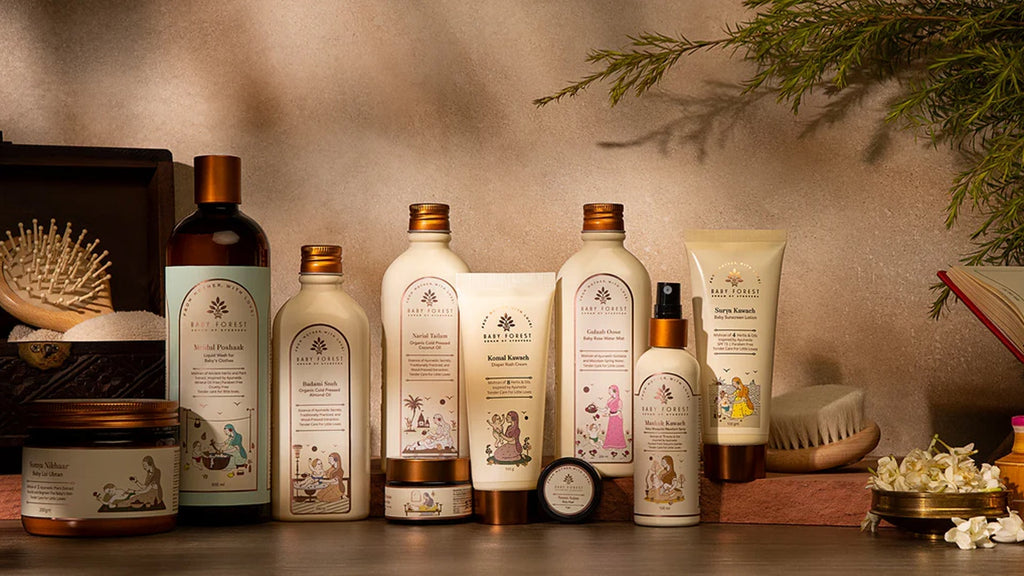
Top Summer Baby Care Essentials for Your Little One
With the changing weather and the temperatures rising, the days grow longer, so ensuring your little one remains comfortable and protected through the summer months becomes a priority. You must take care of your little one, especially during the hot summer days. In this blog, we have curated a list of essential summer baby products and tips to keep your baby happy and healthy during the warm season. From baby skincare to travel essentials, we have a detailed guide designed to cater to your baby's unique needs this summer.

Baby Skincare and Bathing
Summer calls for extra care and attention to skincare and bathing to prevent irritation and keep your baby's skin healthy. The two must-have products are:
Water Baby Wipes

These water wipes are ideal for sensitive skin. They are infused with purified water and free from harsh chemicals, ensuring a gentle cleanse every time.
Rash Healing Cream

With the heat leading to more frequent cases of diaper rash, a reliable cream is essential to soothe and protect your baby's delicate skin.
Baby Sunscreen Lotion

The delicate skin of babies is particularly vulnerable to the harmful rays of the sun. Choose a sunscreen specially formulated for babies, with a high SPF to provide effective protection against UVA and UVB rays. You should apply the baby sunscreen 30 minutes before going out, and reapply frequently to ensure your baby stays protected under the sun.
Keeping your baby cool and comfortable outside is crucial during the hot weather.
Summer Clothing

We opt for warm clothes for winter, and similarly, for summer, it is essential to look at lightweight and breathable fabrics. You can get a crochet baby girl dress or a knotted bodysuit that allows air circulation and keeps your baby cool and stylish.
Baby Rose Water Mist

A refreshing mist can soothe and cool your baby's skin throughout the day. It's perfect for a quick refresh, especially after playtime or when outdoors.
Talc-free Baby Powder

Applying talc-free baby powder after a bath or during diaper changes can help absorb extra moisture and prevent heat rash.
Ensuring your baby is well-hydrated and comfortable is easier with these gentle and effective products.
Baby Body Lotion

After a day out, moisturizing your baby's skin with a baby body lotion helps restore any moisture lost due to exposure to the elements and can help in calming any minor irritations. This routine can help protect your baby's skin from environmental stressors.
Here are some additional tips for summer care to ensure your baby's comfort and safety during the hotter months:
-
Choose the Right Time for Outdoor Activities
Plan outdoor activities during the cooler parts of the day, typically in the early morning or late afternoon. Avoiding the peak sun hours between 10 a.m. and 4 p.m. can help minimize sun exposure. -
Use a Lightweight Stroller with a Sunshade
When taking your baby out for a stroll, use a lightweight and breathable stroller, and make sure it has a sunshade to protect your baby from direct sunlight. -
Dress Weather Appropriate
Dress your baby in loose, lightweight, and light-coloured clothing that covers as much skin as possible. Fabrics like cotton help keeps the skin cool by allowing it to breathe. -
Maintain a Cool Indoor Environment
Use fans, air conditioners, or open windows to create a comfortable and relaxed indoor environment. Consider using a room thermometer to keep track of the temperature, ensuring it's not too hot or too humid. -
Frequent Baths or Cool Washes
Giving your baby a cool bath or gently wiping them down with a damp cloth or baby wipes can help reduce body temperature and soothe irritated skin. -
Monitor Fluid Intake
Ensure your baby is well-hydrated. If they are exclusively breastfed, they might need to nurse more often. If your baby is older and eat solids, offer small amounts of water throughout the day. -
Regularly Clean and Check Baby Gear
Clean all baby gear using a baby-friendly toy and surface cleaner. Including strollers, car seats, and play mats, as heat and humidity can cause bacteria and mold to grow faster than usual.
Summer brings a host of new adventures for you and your baby, but it also calls for a shift in the caregiving routine. You can ensure that your little one enjoys the season safely and comfortably by choosing the right products, such as lightweight cotton clothing, gentle skincare items, and proper sun protection. With this, you can enjoy the sunny days ahead with peace of mind, knowing you're fully equipped to handle the heat!
With these summer essentials, your baby will be well-prepared to face the warm months, and you can enjoy this vibrant season with less stress and more joy.

The Benefits of Regular Baby Massages - A Parent's Guide
As a parent, you're always looking for ways to give your baby the best start in life. One simple yet profound method to boost your baby's health and strengthen your bond is through regular baby massages. Baby massage is an age-old tradition with numerous benefits that can support your child's emotional and physical development. This guide will explore why incorporating massage into your daily routine can be a rewarding experience for both you and your baby.
Baby massage involves gently rubbing and kneading your baby's body with your hands. By using baby massage oils or moisturizers to help glide on the skin smoothly, this practice can be both relaxing and therapeutic. It's a special time for you to connect with your baby, and it has been shown to benefit infants in multiple ways.

Benefits of Baby Massage
1. Enhances Bonding
Touch is a powerful tool in human relationships and plays an essential role in parent-child bonding. Regular massage can improve the connection between you and your baby, providing a time of closeness and mutual comfort. This can be especially beneficial for mothers battling postpartum depression or parents who may have had limited contact with their baby due to medical issues after birth. It's a wonderful way to express your love and care, which can make your baby feel secure and cherished.
2. Promotes Better Sleep
Massaging your baby can help relax their muscles, calm their nerves, and soothe them into a deeper sleep. Many parents find that a gentle massage before bedtime helps their baby to fall asleep more quickly and sleep more soundly. Even research suggests that baby massage can lead to improved sleeping patterns, reduced crying, and greater weight gain in infants. The studies indicate that neurological development is positively impacted by the tactile stimulation provided by regular massage.
3. Aids Digestion and Relieves Gas
Massage can be particularly beneficial in alleviating digestive issues in babies, such as constipation and colic. Gentle abdominal massages increase circulation and can help relieve painful gas and bloating, making your baby more comfortable.
4.Supports Sensory Development
The sense of touch is a key part of your baby's sensory development. Massaging stimulates the nerves under the skin and may help enhance your baby's perception abilities and awareness. It's an excellent way to stimulate nerve connections to the brain and help a baby's tactile sensitivity.
5. Improves Immune System
Giving your baby regular massages can help strengthen their immune system by boosting the production of white blood cells, which are key in fighting off infections. Massaging your little one also stimulates their lymphatic system, which helps clear out toxins and contributes to better overall health. This gentle practice not only keeps them healthier but also adds a soothing touch to their daily routine.
Things to Consider When Buying a Baby Massage Oil
When picking out a massage oil for your baby, it's important to choose one that's kind and gentle on their soft skin. Go for vegan options, which means they're made entirely without animal products—good for the planet and gentle for your little one. Also, make sure the oil hasn't been tested on animals, sticking to cruelty-free choices. Choose natural oils free from harsh chemicals or synthetic additives, which are safer and soothing for your baby's skin. Lastly, check that the oil is derma-safe for sensitive skin to avoid any irritation. This way, you can make sure your baby's massage is safe, soothing, and ethical.
How to Get Started with Baby Massage
Getting started with baby massage is simple, but it's important to do it safely:
-
Choose a Quiet Time:
Select a time when your baby is relaxed but alert, not immediately after a feed or when they are tired. -
Create a Comfortable Setting:
For a cozy and calming atmosphere, use a warm and softly lit room. Place your baby on a soft blanket or towel. -
Use Suitable Oils:
Natural oils like coconut oil or almond oil can be great for a baby's skin. Avoid essential oils unless advised by a professional, as they can be too potent for delicate skin. -
Be Gentle:
Use soft, gentle strokes. You can start with the legs and feet, then move up to the arms, chest, back, and stomach. -
Observe Your Baby's Cues:
Pay attention to how your baby responds. If they seem uncomfortable or upset, stop the session.
Regular baby massages can be a wonderful addition to your daily routine, offering numerous health benefits and enhancing the bond between you and your child. It's a simple, natural way to care for your baby that can make a significant difference in their well-being. Remember, the goal of baby massage is relaxation and connection, so keep the environment calm and enjoyable for the best experience. Happy massaging!
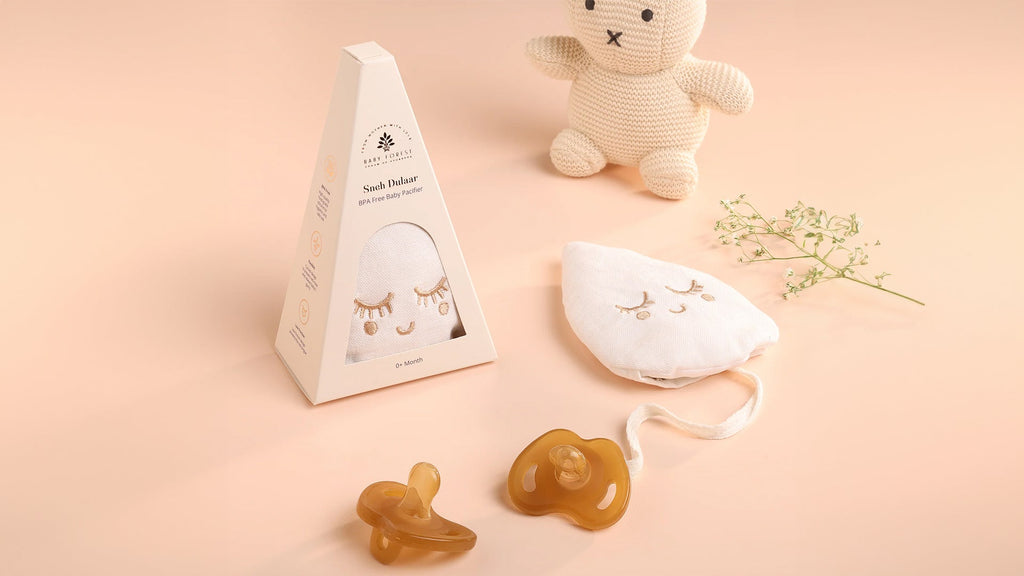
How to Choose the Right Pacifier for Your Baby's Comfort ...
A pacifier for baby can be incredibly helpful for parents, as it can calm a restless baby, encourage sleep, and lower the risk of Sudden Infant Death Syndrome (SIDS). But with so many options in the market, choosing the right pacifier for your baby's comfort and sleep isn't always easy. This blog will guide you through everything you need to know about selecting, using, and maintaining the right pacifier for your baby.
Understanding Baby Pacifiers
Pacifiers are small, nipple-like gadgets made specifically for babies' oral comfort. They come in various shapes and materials, but their primary function is to provide a soothing effect that mimics the comfort babies get from breastfeeding. A good pacifier can significantly calm your baby, helping them feel secure and relaxed, which promotes better sleep.
Selecting the Right Baby Pacifier
When choosing a pacifier, consider these important features:
Material
Look for pacifiers made from food-grade silicone that are durable, soft, and BPA-free to ensure your baby's safety.
Design
A low-friction, flexible design with a skin-like texture can mimic the feel of a mother's breast, making it more likely for your baby to accept the pacifier.
Safety Features
Ensure the pacifier has ventilation holes to prevent saliva buildup and skin irritation around your baby's mouth.
Shape
Orthodontic pacifiers are designed to prevent dental issues later on and support proper oral development. Choosing a pacifier for a baby that combines these elements will contribute to a safer, more comforting experience.
Safety and Hygiene Suggestions
You should always keep your baby's pacifier clean to preventing infections. Wash the baby pacifier with mild, soapy water before its first use and before each subsequent use. It is crucial to examine the pacifier nipple frequently for any indications of wear or harm, and if any defects are found, it should be replaced immediately. Additionally, it is essential to store the pacifier in a dry location, away from direct sunlight and heat sources. Remember, pacifiers should not be sterilized by boiling or subjected to intense heat, as this can degrade the material.
Tips for Introducing a Pacifier
Introducing a pacifier to your baby can be a helpful tool in soothing and comforting them, especially during the early months. However, the timing and method of introduction can play significant roles in how well your baby accepts the pacifier. Here are some tips to help you introduce a pacifier effectively:
Wait Until Breastfeeding is Established
If you are breastfeeding, it's crucial to wait until your baby is proficient at nursing, which typically takes about 3-4 weeks. Introducing a pacifier a little too early can lead to nipple confusion, where the baby might prefer the pacifier over the breast due to the difference in effort needed to extract milk.
Introduce During a Calm Time
You could consider offering the pacifier when your kid is quiet and not too hungry or weary. This can make it easier for your baby to explore the pacifier naturally without associating it with stress or urgent hunger.
Use it to Soothe, Not to Delay Feeding
Use the pacifier to soothe your baby, not as a replacement for feeding. Ensure that your baby is fully fed before offering the pacifier, as this helps prevent misinterpreting their cues for hunger.
Monitor for Any Signs of Discomfort
Monitor and check your baby for any signs of discomfort or rejection. If they consistently refuse the pacifier or seem distressed when using it, take a break and try again another time. Some babies may never take to a pacifier, and that's perfectly okay.
When choosing a pacifier for your baby, it's important to prioritize safety and comfort. By selecting a high-quality, well-designed pacifier and maintaining good hygiene practices, you can provide your baby with a source of comfort that also supports their health and development.
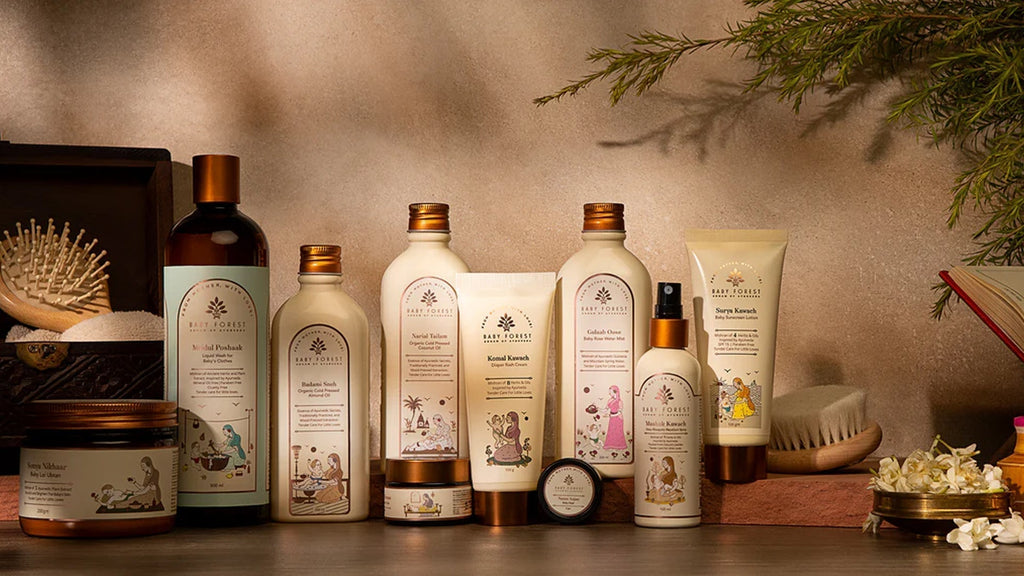
What is the Difference Between Natural Fragrance and Adde...
When it comes to choosing baby products, from lotions and shampoos to baby wipes and creams, parents are faced with a plethora of choices. One aspect that often prompts questions is the difference between natural fragrances and added (or artificial) fragrances in these products. Once you understand these differences, you will be able to make informed decisions for your baby's health and well-being.
What Are Natural Fragrances?
Natural fragrances in products for infants are derived from natural sources, such as plants, flowers, and fruits. These fragrances are obtained through cold pressing, distillation, or extraction. Because they come from natural sources, they often carry the intrinsic benefits of their original plants, such as calming or soothing properties.
Benefits of Natural Fragrances:
-
Gentle on Skin:
For babies with sensitive skin, natural fragrances are less likely to irritate compared to synthetic alternatives. -
Therapeutic Properties:
Some natural fragrances offer therapeutic benefits, like lavender, which is known for its calming effect.
Considerations:
-
Allergies:
Some babies may be allergic to natural ingredients. It's important to monitor for any adverse reactions.
What Are Added (Artificial) Fragrances?
Added or artificial fragrances are chemically created scents designed to mimic natural smells or to create entirely new scents. These fragrances are formulated in labs and can be composed of various chemicals.
Benefits of Added Fragrances:
-
Consistency:
Products with artificial fragrances maintain the same scent over time, providing consistency across batches.
-
Diversity of Scents:
Artificial fragrances can create a wide range of scents that might not be achievable with natural ingredients alone.
Considerations:
-
Skin Sensitivity:
Synthetic fragrances are more likely to irritate sensitive skin, causing reactions such as rashes or redness. -
Health Concerns:
Some studies suggest that certain chemicals in artificial fragrances could have negative health effects over the long term, though more research is needed.
Making the Right Choice for Your Baby
When deciding between baby products with natural or added fragrances, consider the following tips:
-
Know Your Baby's Skin:
If your baby has sensitive skin, opting for fragrance-free or naturally scented products might be the best choice. -
Read Labels Carefully:
Look for products that specify "natural fragrance" or "fragrance-free" if you wish to avoid synthetic scents. -
Patch Test:
Before you use any new product on your baby, do a patch test by applying a small amount on their arm or leg to check for any adverse reactions. -
Consult a Paediatrician:
If in doubt, consulting with your child's paediatrician can provide personalized advice based on your baby's specific health and skin needs.
Whether you choose baby products with natural fragrances, added fragrances, or no fragrances at all depends on your preferences and your baby's skin sensitivity. Being informed and cautious can help ensure that your choices support your baby's health and happiness.
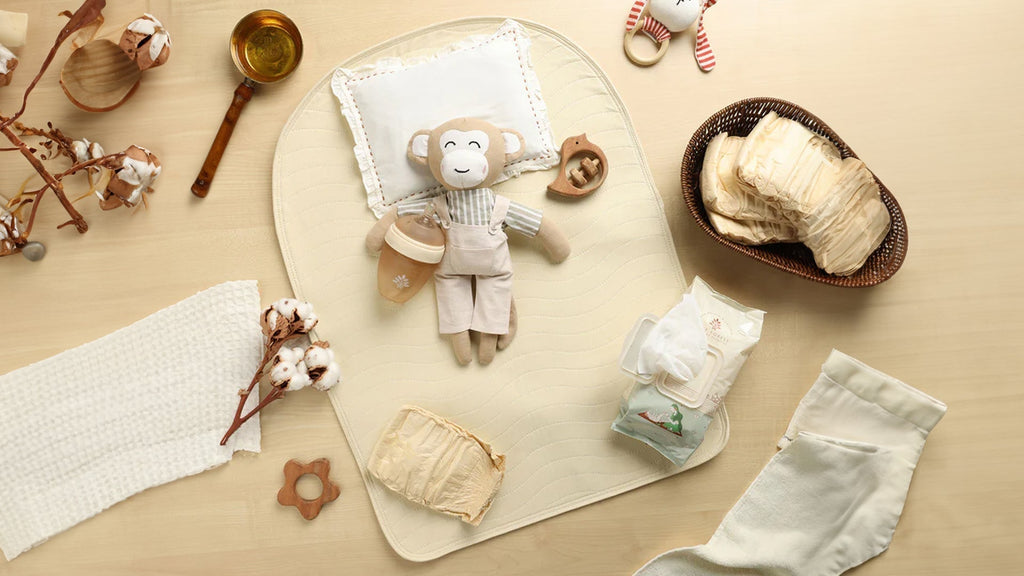
The Benefits of Using Dry Sheets in Diaper Changing and S...
As a parent, your baby's comfort and health are your top priorities. One simple yet effective way to ensure both during diaper changes and sleep time is by incorporating dry sheets into your routine.
What Are Dry Sheets?
Dry sheets, also known as absorbent sheets or waterproof bed protectors, are designed to keep moisture away from your baby's skin and bedding. Made from layers of materials, including absorbent and waterproof fabrics, these sheets are engineered to draw moisture away from the surface, keeping the baby dry and comfortable. Unlike traditional cloth or rubber sheets, modern dry sheets are breathable, soft, and safe for a baby's delicate skin, making them an essential part of baby care routines.
Let's dive into why these little sheets can make a big difference.
-
Keeping Baby Dry and Happy
Dry sheets are designed to provide a waterproof barrier that helps keep moisture away from your baby's skin. During diaper changes, a dry sheet can prevent any accidental leaks from reaching the changing table or any surface you're using. Placing a dry sheet under your little one at night can help manage any leaks, ensuring they stay dry and comfortable. This is crucial because a dry environment is essential for preventing diaper rashes, which are uncomfortable for your baby and stressful to manage.
Related Read - Is Your Baby Suffering From Diaper Rashes? Here Are The Best Ways to Treat Diaper Rashes
-
A Simple Solution for Better Sleep
As we know, babies are sensitive to discomfort, which can interrupt their precious sleep. A wet diaper or any moisture can be particularly disruptive. Using a dry sheet creates an additional layer of protection that helps maintain a dry sleeping environment. This can lead to longer, more peaceful sleep periods for your baby (and, let's face it, for you too!). Better sleep supports their overall development and ensures they're happier during their waking hours. -
Easy Cleanups
Let's talk practicality. Dry sheets are incredibly easy to use and change, making cleanups a breeze. For environmentally conscious parents, there are also reusable options available that can be washed and used again. -
Portable Convenience
Dry sheets are lightweight and portable, making them an essential item in your diaper bag. Whether you're visiting grandparents, enjoying a family outing, or travelling, they ensure that you can provide a clean and dry-changing surface anywhere. This flexibility can make diaper changes on the go less stressful for both you and your baby. -
Protecting Your Gear
Lastly, dry sheets are not just about keeping your baby dry; they also protect your changing tables, cribs, and car seats. Moisture can damage these surfaces over time or require extensive cleaning. Using dry sheets helps preserve the condition and longevity of your baby gear, saving you money and hassle in the long run.
Choosing the Right Dry Sheet
When selecting a dry sheet, consider the following factors to ensure you pick the best one for your baby:
- Material: Search for soft materials that are kind to the skin and devoid of toxic substances.
- Size: Choose a size that fits your baby's crib, cot, or bed snugly, covering the area effectively.
- Absorbency: Opt for sheets with high absorbency to keep moisture away from your baby's skin.
- Ease of Cleaning: Dry sheets that are machine washable and quick to dry will make your life easier.
Tips for Using Dry Sheets Effectively
- Regular Rotation: Have multiple dry sheets on hand to ensure you always have a clean one ready for use.
- Proper Placement: Ensure the dry sheet is laid out flat and securely in place to prevent bunching or shifting.
- Layering: For added protection, consider layering a dry sheet over a regular fitted sheet.
- Monitoring: Regularly check the dry sheet for dampness and change it immediately if it's wet to keep your baby dry and comfortable.
Beyond Dry Sheets: A Holistic Approach to Baby Comfort
While dry sheets are fantastic, they're just one piece of the puzzle. Here are additional tips to ensure your baby's ultimate comfort and well-being:
-
Choose the Right Diapers:
Opt for high-quality, absorbent diapers that fit well. The right diaper can make a significant difference in preventing leaks and discomfort. -
Regular Diaper Changes:
Keep your baby fresh and comfortable by changing diapers regularly, especially before bedtime or after meals. -
Diaper Rash Creams:
Have a good diaper rash cream on hand. Applying a barrier cream can provide an extra layer of protection against moisture.

-
Comfortable Sleep Environment:
Ensure your baby's sleeping area is quiet, dark, and at a comfortable temperature. Establishing a regular bedtime routine can enhance the quality of your sleep. -
Hydration and Diet:
For older babies, adequate hydration and a balanced diet can influence diaper habits, making them more predictable and manageable. -
Parental Self-Care:
Remember, a relaxed and happy parent can better attend to a baby's needs. Taking care of yourself is also taking care of your baby.
Dry sheets are a game-changer for new parents, offering unparalleled convenience, hygiene, and comfort for babies during diaper changes and sleep time. By choosing the right dry sheet and using it effectively, parents can ensure their little ones stay dry, comfortable, and happy. Remember, the journey of parenthood is filled with trials and errors, but with the right tools and a loving heart, every challenge becomes a stepping stone towards a fulfilling experience.
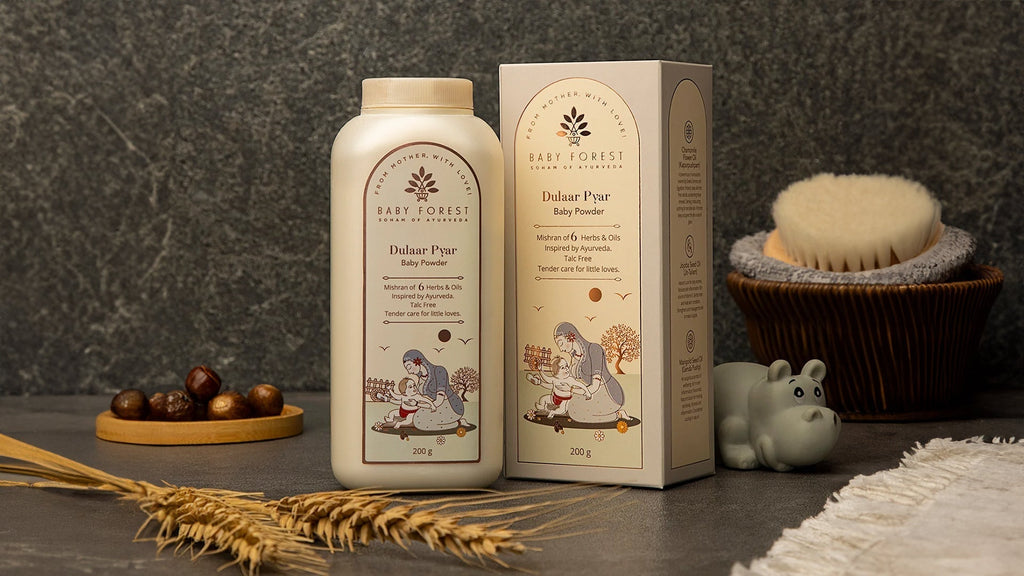
Why Talc-Free Baby Powder is a Must for Summer Heat?
As temperatures soar during the summer months, keeping the little ones comfortable becomes a priority for every parent. An essential item in many households is baby powder, especially to combat the heat and humidity that can cause discomfort and skin rashes in babies. However, the type of baby powder you choose is crucial. In this blog, we'll explore why talc-free baby powder is a safer and healthier choice for your baby during the hot season.
All About Talc and Its Concerns
Traditionally, a lot of baby powders used to have talc in them, which is basically made up of magnesium, silicon, and oxygen. Talc is popular because it's really good at soaking up moisture and reducing friction that causes chaffing , which is why it was often used in baby powders and other beauty products. However, there have been a few concerns about talc's safety over the years. The main issue is its potential contamination with asbestos, a known carcinogen, and the risk of respiratory problems if infants inhale the fine particles.
In light of these concerns, many parents and health experts advocate for the use of talc-free products, particularly for babies who are more vulnerable to the adverse effects of these particles.
What is Talc-free Baby Powders?
Talc-free baby powders are a gentle alternative to traditional baby powders that contain talc, a mineral known for its moisture-absorbing properties. Instead of talc, these powders use natural, plant-based ingredients such as Cornstarch, Chamomile Oil, and Oats Kernel, which are equally effective at keeping moisture at bay without the associated health risks of talc, such as potential contamination with asbestos and respiratory issues from inhalation.
Benefits of Talc-Free Baby Powder
-
Safer Ingredients:
Talc-free baby powders are usually made with cornstarch or other plant-based ingredients like aloe vera. These natural alternatives are gentle on the baby's sensitive skin and are free from asbestos risks. -
Prevents Rash:
During summer, the risk of rashes increases due to the heat and humidity. Talc-free baby powders absorb excess moisture naturally, keeping the baby's skin dry and comfortable, thereby preventing rashes. Additionally you can use Rash Healing cream. -
Avoids Respiratory Risks:
The particles in talc-free powders are generally larger and less likely to be inhaled than those in talc-based powders. This reduces the risk of respiratory problems, which can be serious for children. -
Natural Skin Care:
Many talc-free powders contain additional natural ingredients that benefit the baby's skin. Ingredients like aloe vera and chamomile can help soothe the skin and prevent irritation, making them ideal for use in sensitive diaper areas during the hot months.
Choosing the Right Talc-Free Baby Powder
When selecting a talc-free baby powder, look for products that are:
-
Natural:
Ensures that the product is free from harmful chemicals and genetically modified organisms. -
Artificial Fragrance-Free:
Added fragrances can irritate a baby's delicate skin. Opt for products with no added fragrance to avoid potential allergens. -
Derma Safe:
Choose products that are derma-safe and approved for use on sensitive skin.
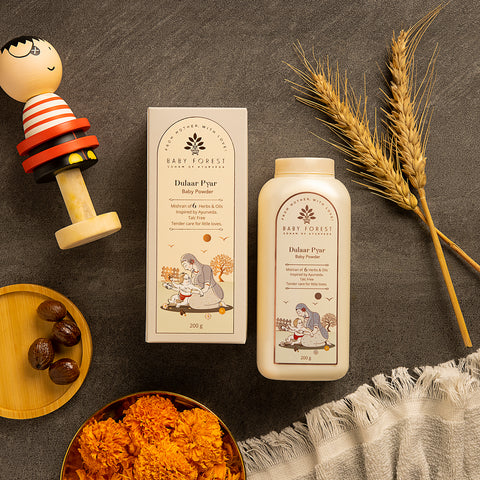
How to Use Talc-Free Baby Powder Safely
To maximize benefits and minimize any risks, even with talc-free powders, it's important to use baby powder correctly:
-
Apply Sparingly:
Use a small amount of powder and keep it away from the baby's face and eyes to avoid inhalation. -
Direct Application:
Apply the powder directly to your hands, away from the baby, and then to the baby's skin. This method helps to control the amount of airborne particles.
Talc-free baby powder is a much safer and healthier option for summer baby care. By incorporating talc-free baby powder into your daily routine, you can ensure that your baby enjoys the summer safely and comfortably. With natural ingredients that are gentle on the skin and effective at moisture absorption, talc-free powders can help keep your baby dry, comfortable, and happy during the hot weather. Always opt for natural, cruelty-free, and derma-safe products to ensure the best care for your little one's delicate skin. Enjoy a worry-free summer with the right products for your baby's needs! Whether at home or on the go, this simple change can make a big difference in your baby's well-being during the warm season.

A Comprehensive Guide To Choose The best pillow for your ...
When you welcome a new baby into your home, every little decision can seem overwhelming, especially when it comes to ensuring their comfort and safety. One such decision is choosing the right pillow for your newborn. With a myriad of options available, it's crucial to select a pillow that not only provides the necessary support but also aligns with your baby's health and developmental needs. In this guide, we'll explore why the mustard seed pillow is considered one of the best choices for newborns and also understand its numerous benefits.
Understanding your Newborns' Needs
Before we discuss the specifics of pillows for newborns, let's discuss why newborns need different support than older babies and adults. Newborns have delicate structures, including their neck, spine, and head. They require a pillow that supports natural posture, prevents flat head syndrome, and ensures a safe & comfortable sleep environment. The choice of pillow can significantly impact their well-being and development during these critical early months.
Mustard Seed Pillow for Newborns: An Ancient Solution
The mustard seed pillow is not a new invention but rather a traditional solution that has been used for generations in many cultures around the world. This type of pillow is filled with tiny mustard seeds, which provide a firm yet adjustable surface for your baby's head. The flexibility of the mustard seeds allows the pillow to mould perfectly to the shape of your baby's head, providing support without unnecessary pressure.

Benefits of a Mustard Seed Pillow for Newborn
-
Prevents Flat Head Syndrome
One of the most significant benefits of using a mustard seed pillow is its ability to prevent the development of flat head syndrome. This condition, known as plagiocephaly, develops when a baby's head flattens because of sustained pressure on a specific spot. The malleable nature of the mustard seed pillow helps distribute pressure evenly around the baby's head, reducing the risk of flat spots.
-
Natural and Safe:
Mustard seeds are completely natural and non-toxic, making them a safe filling for newborn pillows. Unlike synthetic materials, mustard seeds do not emit harmful chemicals that could irritate your baby's sensitive skin or respiratory system.
-
Supports Neck and Spine:
One of the standout benefits of the mustard seed pillow is its exceptional ability to support the delicate neck and spine of a newborn. The unique structure of the mustard seeds allows the pillow to conform naturally to the shape of the baby's head, guaranteeing that the neck and spine maintain a neutral alignment. This alignment is crucial for preventing any strain on these developing areas and promotes a healthy posture from an early age. By distributing the baby's head weight evenly, the mustard seed pillow reduces the risk of common issues like flat head syndrome while simultaneously providing the necessary support for the neck and spine
-
Durable and Long-lasting:
Mustard seed pillows are incredibly durable and can last for many years if properly cared for. They do not lose their shape or support over time, unlike foam or feather pillows, which can become lumpy or flat.
Related Read - Mustard Seeds Pillow Benefits: Ideal for Your Newborn's Comfort and Health
How to Find the Ideal Newborn Pillow?
The ideal newborn pillow should be firm enough to support the baby's head yet soft enough to prevent any undue pressure that could lead to flat spots. It should be made of natural, breathable materials to maintain a comfortable temperature and be adjustable to cater to the growing baby's needs. A mustard seed pillow embodies these characteristics perfectly, offering a traditional yet effective solution for newborn sleep comfort.
Care and Maintenance
Caring for a mustard seed pillow is straightforward. Regularly airing the pillow and exposing it to sunlight can help maintain its freshness and prevent moisture buildup. The pillow cover should be washable for easy cleaning. You should keep checking the pillow regularly for any signs of wear and tear to ensure it remains safe and effective for use.
Conclusion
Choosing the best pillow for your newborn is a critical decision that can affect their comfort, safety, and development. The mustard seed pillow, with its natural, adjustable, and supportive properties, stands out as an excellent choice for many parents. By understanding the benefits of a mustard seed pillow and knowing what to look for when choosing one, you can provide your baby with a comfortable, supportive sleeping environment that promotes healthy growth and development. Remember, every baby is unique, so it's essential to consider your child's specific needs when making your selection. Here's to peaceful nights and healthy babies!
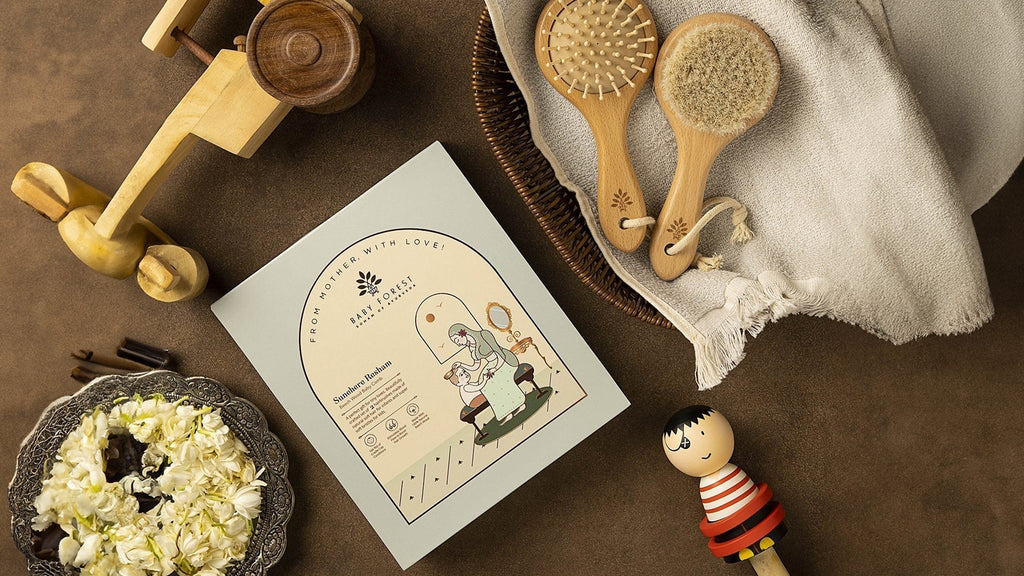
The Importance of Using a Gentle Comb for Your Baby's Hair
Infant hair care is more than a simple grooming routine; it's an essential part of their overall health and well-being. Babies' hair and scalp are very delicate, and they require gentle care to prevent discomfort or harm. This article will explain why using a gentle comb for your baby's hair is crucial, highlight the risks associated with regular combs, and outline the features and benefits of a gentle baby comb.
Understanding Baby's Hair and Scalp
Baby’s scalp is sensitive, and their hair is fine and fragile. Their skin and hair are still developing and can be easily irritated by rough handling or harsh materials. A baby's scalp can also be prone to conditions like cradle cap, which involves patchy, scaly skin. Hence, gentle care is essential to avoid aggravating these conditions or causing discomfort.
The Risks of Using Regular Combs
Regular combs, designed for adults or older children, are often too harsh for a baby's tender scalp. Their hard materials and sharp teeth can scratch or irritate the skin, leading to discomfort or even skin infections. Moreover, these combs can tug at fine baby hair, causing breakage or pain during grooming.
How to Choose the Right Baby Comb
When you look at buying a baby comb, you can consider the following factors:
-
Material:
Look for natural materials like wood and soft goat hair that are safe and gentle for your baby. -
Design:
Choose a comb with rounded teeth and a comfortable handle for easy and safe grooming. -
Size:
A compact size is preferable for the precise combing of fine baby hair and for convenient storage.
Features of Baby Forest’s Gentle Baby Comb
Our gentle baby comb is designed with the baby's delicate scalp and hair in mind.
-
Super Soft Goat Hair:
Ideal for infants and kids, these bristles are gentle enough to massage the scalp without causing irritation. -
100% Natural Beech Wood:
This baby comb is not only eco-friendly but also exceptionally durable and safe for the baby. -
Specially Designed Teeth:
The teeth of the baby comb are rounded and spaced to glide through fine hair without pulling or snagging.
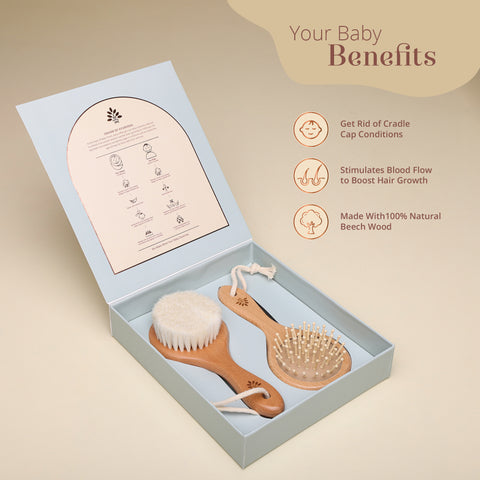
Benefits of Regularly Combing Your Baby's Hair with a Gentle Comb
Regularly combing your baby's hair with a gentle comb is more than just a routine grooming activity; it is an essential practice that offers numerous benefits for both the baby and the parent.
-
Promotes Healthy Hair Growth
Combing regularly with a soft comb aids in stimulating the scalp, which boosts blood flow to the hair roots. This stimulation promotes healthier and stronger hair growth by ensuring that the hair follicles receive ample nutrients and oxygen. Even spreading the scalp's natural oils along the hair shaft nourishes the hair, thus reducing its susceptibility to breaking.
-
Detects and Prevents Scalp Issues Early
Regular combing allows parents to closely inspect their baby's scalp regularly, making it easier to spot any potential issues such as dryness, cradle cap, or unusual spots early on. Early detection means that any conditions can be addressed promptly, preventing discomfort for the baby and potentially avoiding more serious complications.
-
Alleviates Cradle Cap
Cradle caps, characterized by scaly or crusty patches on the scalp, are common in babies. Regularly combing your baby's hair with a gentle comb can help loosen and remove these scales in a gentle manner, especially when combined with appropriate baby oil or shampoo. This keeps the baby's scalp clean and helps alleviate the symptoms of cradle cap.
Related Read - Dealing with Cradle Cap: Causes, Treatment Options, and Proactive Prevention
Combing Techniques and Tips
To make the most of your infant's hair care routine, consider these tips:
-
Gentle Approach:
Always comb gently, starting from the tips and working your way up to the roots to detangle hair without pulling. -
Regular Routine:
Make combing a part of your daily routine to keep your baby's hair neat and to monitor the health of their scalp. -
Cleanliness:
Keep the comb clean to prevent the buildup of oils or cradle cap flakes, ensuring hygiene.
Related Read - An Ideal Hair Care For Babies- What You Must Know?
ConclusionCaring for your baby's hair with a gentle hairbrush is an act of love and attention. It not only ensures their comfort but also promotes healthy hair growth and scalp health. Combing your baby's hair is a loving gesture that keeps them comfortable and supports their hair and scalp health. Choose the right newborn hairbrush and comb their hair gently, making it a soothing and bonding experience. Remember, the key is to be gentle and patient and to use the right tools to care for your baby's delicate hair and scalp.
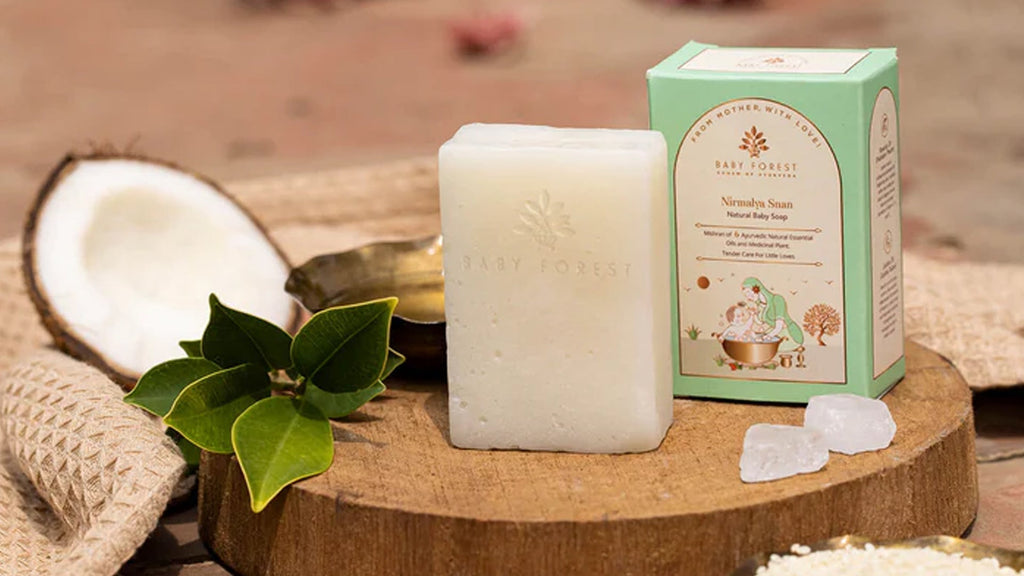
Natural Baby Soaps for Chemical-Free Bath Time
Because so many household goods include chemicals, it is essential that we put our children's health first when it comes to the purity of the products they use. Whether your kid is seven days, seven weeks, or seven months old, one thing remains constant: their sensitive and gentle skin. As a result, many bath and skin care products you use on yourself might cause rashes and irritation. Parents have become increasingly mindful of choosing baby products, which has led to a growing preference for natural baby products.
Bathing your baby is not just a task but a nurturing experience for their well-being. This blog will help you understand the benefits of choosing natural baby soaps and provide guidance on how to select the best soap for infants, guaranteeing a chemical-free bathing experience.
Why Choose Natural Baby Soaps?
Our skin is the biggest part of our body that shields our insides from the outside world. This is especially important for babies because their skin is significantly thinner than that of adults. This makes a baby's skin more delicate and also lets chemicals from normal soap get into the skin more easily. One study found that babies exposed to harsh soaps and shampoos are more likely to get skin problems like eczema and other skin irritations.
This is where natural baby soaps help with their organic ingredients, which makes it safer with no synthetic smells or harsh chemicals in them. These soaps only contain natural ingredients like coconut oil and shea butter. These natural ingredients are gentle and soft on a baby's skin.
How to Choose the Right Natural Baby Soap for Your Baby?
Choosing the right natural baby soap is crucial for your little one's delicate skin. With so many alternatives available, it might be difficult to choose the best one. However, focusing on specific qualities and ingredients can guide you in making a healthier choice for your baby. Here's how to ensure the soap you select is gentle, safe, and beneficial for your baby's bath time.
-
Paraben-Free
Parabens are preservatives used to prolong the shelf life of products, but they can disrupt hormone function, which is especially risky for babies. Opting for paraben-free baby soap ensures that your child is not exposed to these chemicals, making bath time safer.
-
Tear-Free
A tear-free formula is essential for baby soaps to prevent eye irritation during bath time. This means the soap is gentle enough that it won't sting your baby's sensitive eyes, making for a more pleasant bathing experience for both of you.
-
Natural Ingredients
Natural ingredients are the cornerstone of a good baby soap. Look at infant soaps with ingredients such as Jojoba Oil, Castor Oil, Coconut Oil, Sesame Oil, Rosehip Oil, and Aloe Vera. Chemical additives can be harsh on a baby's skin, leading to dryness and irritation. Natural soaps, on the other hand, use ingredients that are gentle and nourishing.
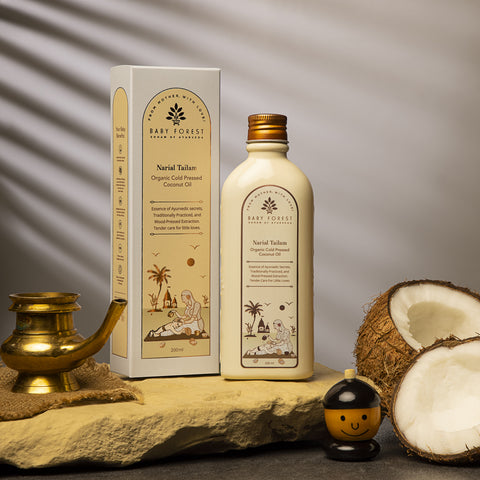
-
Vegan
Vegan baby soaps are made without any animal products or by-products, aligning with eco-friendly and cruelty-free practices. These soaps are also more likely to contain plant-based ingredients that are gentle and beneficial for the skin.
How to Use Baby Forest's Nirmalya Snan Natural Baby Soap?
To use the soap bar, simply wet your baby's skin with warm water, then gently rub the soap bar over their skin to create a soft lather. Massage the lather gently across their body with your hands or a soft washcloth. After ensuring their skin is thoroughly cleansed, rinse off the lather with plenty of water, making sure no soap residue remains.
When choosing baby care products, it's important to consider your child's well-being and the environment. Natural baby soaps are a great option, as they are gentle on your baby's skin and free from harsh chemicals. This helps create a safe and enjoyable bathtime experience for your little one. By choosing natural products, you're also contributing to a more sustainable world, reducing your exposure to harmful chemicals. This is a worthwhile investment in your child's health and the future of our planet.

